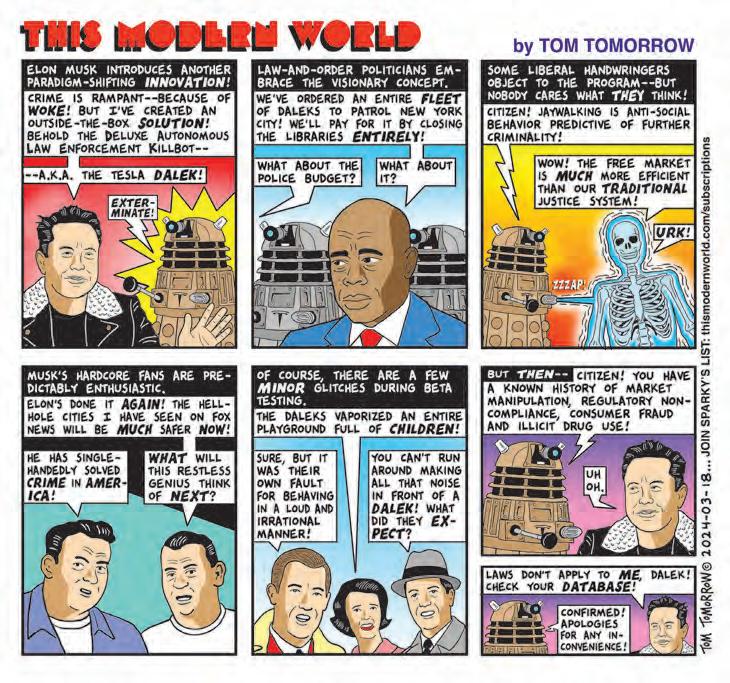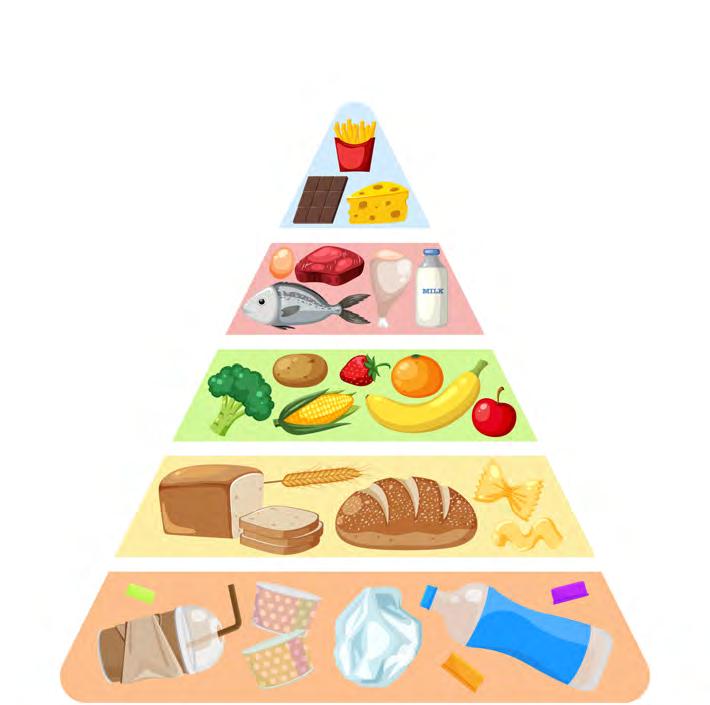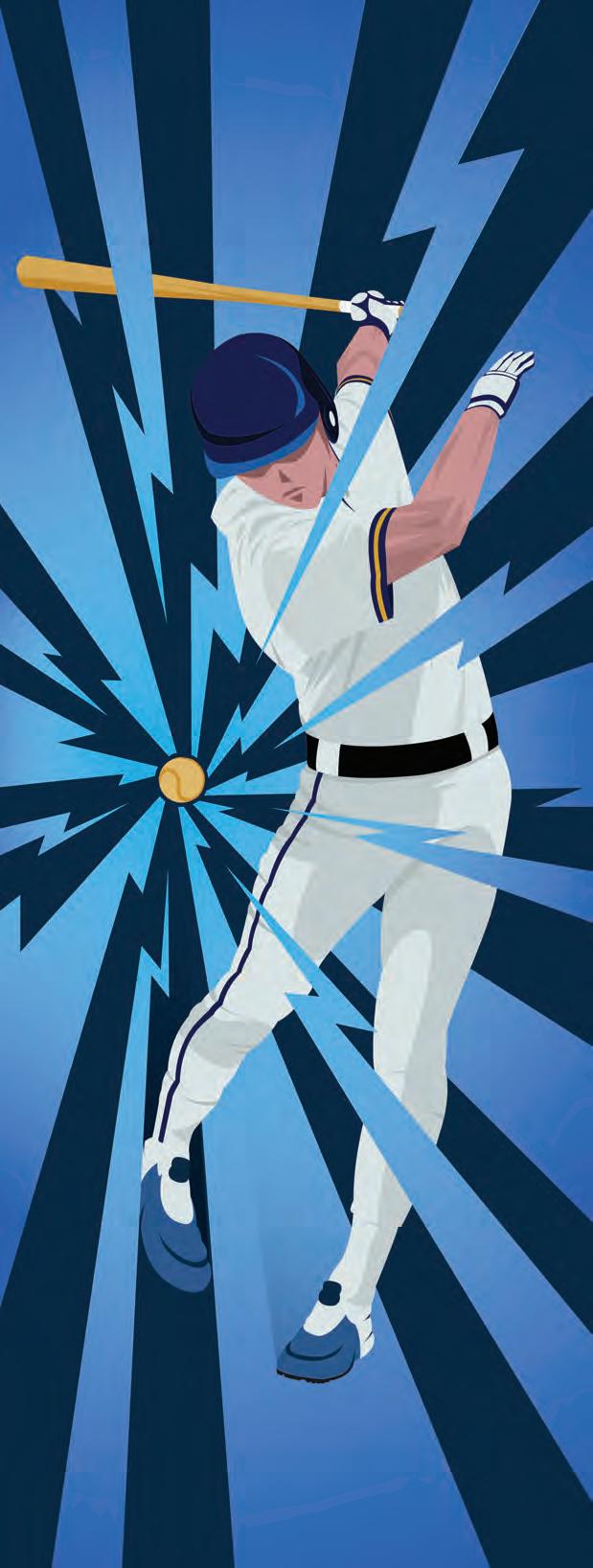




IN THIS ISSUE: PAGE 6 PAGE 6 SPORTS SPOTLIGHT PAGE 44 HOME & GARDEN PAGE 40 SPONSORED BY SPONSORED BY APRIL 2024 APRIL 2024





AT SHEPHERDEXPRESS , WE ARE COMMITTED TO ENVIRONMENTAL SUSTAINABILITY AND RESPONSIBLE PRACTICES.
SPONSORED BY

SPONSORED BY SPONSORED BY


PUBLISHER & EDITOR-IN-CHIEF:
Louis Fortis (ext. 3802)
GENERAL MANAGER:
Kevin Gardner (ext. 3825)
MANAGING EDITOR:
David Luhrssen (ext. 3804)
BUSINESS MANAGER:
Peggy (ext. 3832)
ASSISTANT TO THE BUSINESS MANAGER:
Tanya Bielinski (ext. 3808)
EVENT COORDINATOR:
Jourdain LaFrombois (ext. 3810)
ACCOUNT EXECUTIVES:
Bridgette Ard (ext. 3811)
Julee Mitchell (ext. 3831)
Tyler R. Klein (ext. 3815)
SALES MANAGER:
Jackie Butzler (ext. 3814)
BUSINESS DEVELOPMENT MANAGER:
Chuck Hill (ext. 3822)
IN MEMORY OF DUSTI FERGUSON (OCTOBER 18, 1971 – NOVEMBER 20, 2007)
WEBMASTER:
Barry Houlehen (ext. 3807)
DIGITAL STRATEGIST:
Sophia Hamdan (ext. 3803)
STAFF WRITER & CIRCULATION COORDINATOR:
Blaine Schultz (ext. 3813)
INTERN:
Sabrina Rosler
Layout and design by WaterStreet Creative.

Distribution: New issues of the Shepherd Express magazine are on the street, on the first Wednesday of each month, free of charge. The Shepherd Express may be distributed only by authorized distributors. No person may, without prior written permission of the Shepherd Express, take more than one copy of each monthly issue. Mail subscriptions are available. No refunds for early cancellations. One year (12 issues) via First Class mail: $100.00.
SPONSORED BY

PRINTED MATERIALS ARE DESIGNED TO BE RECYCLABLE, ALLOWING READERS TO PARTICIPATE IN THE CIRCULAR ECONOMY AND PLAY A PART IN PRESERVING THE ENVIRONMENT.


NEWS
Planting and Tending Trees for the Planet 09 This Modern World
The Republican Party Is Stuck with Putin and Trump — Taking Liberties
How Will the Carbon Tax Slow Climate Chaos? — Issue of the Month
Shamiah Johnson: Awareness, Resources (and Memories) for Dementia — Hero of the Month
Milwaukee’s Commissioner of Health Mike Totoraitis — MKE SPEAKS: Conversations with Milwaukeeans FOOD & DRINK 20 RuYi Celebrates Fine East Asian Dining at Potawatomi 22 The Caviar of Turnips — Flash in the Pan 24 The Question About Wine Shops — Beverages SPECIAL SECTION 26 Health & Wellness 26 Up In Smoke — Cannabis 30 Is Plastic Part of Your Food Pyramid? — True Health 32 Facing Down Fear — Out of My Mind 36 It Takes Two to Create a Toxic Relationship — Ask Ally 38 Taxes, Extensions and All That Jazz — Personal Finance 40 Home Design Trends Tips to Refresh the Home — Home & Garden 44 How Will the Brewers Do this Season? — Sports Spotlight 46 Nourishing Your Furry Friend: Dry Skin Remedy for Pets — Pets CULTURE 48 Saving Books From the Bonfire 52 Sonic Concoctions: Scam Likely Expand Their Musical Palate on New Album 56 This Month in Milwaukee HEAR ME OUT 62 Scary Stranger Sleepovers — Dear Ruthie 64 The Persistent Enigma of the Awful Gay Republican — My LGBTQ POV ART FOR ART'S SAKE 66 From the City that Always Sweeps 14 44 12
06
10
12
14
16
FOR MORE UNIQUE CONTENT, VISIT SHEPHERDEXPRESS.COM.
ME SHEPHERD EXPRESS MAKES NO REPRESENTATIONS OR WARRANTIES OF ANY KIND, WHETHER EXPRESSED OR IMPLIED, REGARDING ANY ADVERTISING. DUE DILIGENCE IS RECOMMENDED BEFORE ENTERING INTO ANY AGREEMENT WITH AN ADVERTISER.SHEPHERD EXPRESS WILL NOT BE HELD LIABLE FOR ANY DAMAGES OF ANY KIND RELATING TO ANY AD. PLEASE CHECK YOUR AD THE FIRST DAY OF PUBLICATION AND NOTIFY US OF ANY CHANGES. WE ARE NOT RESPONSIBLE FOR ERRORS IN ADVERTISING AFTER THE FIRST DAY. WE RESERVE THE RIGHT TO EDIT, REJECT OR RECLASSIFY ADVERTISEMENTS AT OUR SOLE DISCRETION, WITHOUT NOTICE. WE DO NOT KNOWINGLY ACCEPT ADVERTISEMENTS THAT DISCRIMINATE OR INTEND TO DISCRIMINATE ON ANY ILLEGAL BASIS, OR ARE OTHERWISE ILLEGAL. NO REFUNDS FOR CANCELLATION AFTER DEADLINE, NO COPY CHANGES EXCEPT TO PRICE OR TELEPHONE NUMBER. 207 E. Buffalo St., Suite 410, Milwaukee, WI 53202 Phone: 414/276-2222 Fax: 414/276-3312 Advertising Inquiries: jackie@shepex.com e-mail: info@shepex.com URL: shepherdexpress.com OUR PUBLICATION IS PRINTED ON PAPER THAT IS CERTIFIED BY THE FOREST STEWARDSHIP COUNCIL (FSC), SUSTAINABLE FORESTRY INITIATIVE (SFI), AND THE AMERICAN TREE FARM SYSTEM (ASTFS), ENSURING IT COMES FROM RESPONSIBLY MANAGED FORESTS. IN ADDITION TO OUR ECO-FRIENDLY PAPER, WE UTILIZE INKS THAT INCORPORATE RENEWABLE RESOURCES SUCH AS SOYBEAN OIL, LINSEED OIL, CASTOR OIL, TALL OIL ROSIN, AND GUM ROSIN. THESE CHOICES REFLECT OUR DEDICATION TO REDUCING OUR ENVIRONMENTAL IMPACT AND PROMOTING A GREENER FUTURE. MOREOVER, OUR DEDICATION TO SUSTAINABILITY EXTENDS TO THE END OF THE PUBLICATION'S LIFECYCLE. OUR
SCAN
COVER: Earth illustration by kjolak/Getty Images. Trees photos by sarayut/Getty Images. Coniferous tree style one by irklig/Getty Images. Coniferous tree style two by Nastco/Getty Images. Composition by Michael Burmesch. Sports Spotlight illustration by Tim Czerniakowski. Home & Garden photo by jchizhe/Getty Images.
4 | SHEPHERD EXPRESS


6 | SHEPHERD EXPRESS NEWS
BY VIRGINIA SMALL BY VIRGINIA SMALL
Trees foster a thriving community and planet in myriad ways. They filter the air we breathe, improving its quality. They absorb carbon dioxide and mitigate effects of climate change. They provide cooling shade for people, buildings and neighborhoods. They counter the “urban heat island” that results from concrete and other materials holding heat and elevating temperatures by day and night. Trees also help to decrease flooding and erosion and provide habitat for wildlife. They support people’s physical and mental health. And, of course, trees are beautiful.
Nonetheless, people often take trees for granted. Or, worse, actions such as careless mowing and excessive mulching can harm them.
Many experts consider tree planting and maintenance absolutely essential to countering the global climate crisis. They call for retaining trees as long as possible and cutting them down only when they are irreparably diseased or posing safety risks.
In forest ecology, canopy refers to the upper layer, or habitat zone, created by mature trees. Tree preservation, appropriate planting, and proper tree care all contribute to a sustained or enhanced tree canopy. In contrast, tree removal, site clearing during development, natural incidents such as fire and storms, and inadequate tree care can decrease tree canopy. Maintaining tree canopy involves governmental and other collective investments in public spaces, as well as individual actions on private property.
Milwaukee’s urban tree canopy soon will get a big boost. The U.S. Department of Agriculture, through the Forest Service, has announced that it will grant $12 million to address disparities in the amount and quality of trees in Milwaukee’s public realm. The City of Milwaukee (Environmental Collaboration Office and Urban Forestry Department), Milwaukee County Parks, Metropolitan Milwaukee Sewerage District (MMSD), Milwaukee Public Schools and several community-based organizations are collaboratively planning for how to use the funds. Projects will in -
clude tree planting, pruning and other maintenance; “de-paving” some areas and replanting them with trees (such as on school grounds); work-force development in urban forestry, and public outreach and education.
Randy Krouse, the city’s forestry services manager, told Shepherd Express that all projects to be funded have been selected based on sites with the highest need for trees, flooding issues, heat vulnerability, socioeconomic factors and percentage of tree canopy.
Drawing on many sources of data has allowed planners to create an “equity index” to develop objective assessments of need, according to Aaron Saeugling of Forestry Services. Two public meetings were held in March to get community feedback about proposed projects.
Krouse said that the forestry department manages about 194,000 street tree sites, with a goal of having “as many healthy trees standing as safely as possible.” The department manages its own nursery in Franklin, where it grows 20,000 street trees. “We try to maintain a diverse array of trees,” said Krouse. “Not all trees can survive the harsh conditions of urban streetscapes.”
Milwaukee’s tree-canopy coverage is currently about 25 percent, said Krouse. He would like to see that rise to 30 or 40 percent. “Achieving that will require efforts by many entities and individuals,” he said.
Everyone can help steward our tree canopy, regardless of their situation.
Start today. A popular adage is, “Twenty years ago was the best time to plant a tree. The second-best time is now.” We can focus on trees beyond Earth Day and Arbor Day.
Choose the right tree for the right place. Tree selection should follow exploration of multiple goals, a site’s growing conditions, and the life cycle and mature habitat of specific trees, and what that will mean. For example, oaks are stellar options environmentally, but not every urban lot can accommodate the long-term maturation
of a mighty oak. Many different tree species contribute to biodiversity. Personal preferences also have their place. Consider relationships you have enjoyed with specific trees and how that might inform your choices. Thoughtful research and planning up front will pay dividends down the road.
Take advantage of free and affordable trees. Any fourth-grade student in Wisconsin can apply to the Department of Natural Resources (DNR) to receive a tree to plant to celebrate Arbor Day. Some local organizations offer free seedling trees, including the River Revitalization Foundation. The DNR’s reforestation program offers high-quality native tree seedlings and shrubs to plant on private and public lands for conservation.
Seek advice from professionals. Planting logistics vary based on a tree’s size; whether it is bare-root, potted, or balled-and-burlapped; and site conditions. Look to plant nursery staff, books, or reputable online sites, such as the DNR. https://dnr.wisconsin.gov/ topic/treeplanting/tips
Water trees. Krouse said that it’s essential to regularly and deeply water young trees and to continue to do so whenever they are stressed by drought or other factors.
Mulch, but in moderation. A thin layer of an organic mulch (something that will decompose and become soil) helps protect tree roots and nourish trees. Beware of overdoing it. Krouse said the “mulch mountains” often seen piled up beneath trees actually will harm them by depriving the roots of needed oxygen. That compromises tree health and leads to premature decay. A mulching rule of thumb is to always expose a tree’s “root flare,” the point of the trunk where roots begin to fan out. It’s also best to have mulch or ground covers directly next to trees, not turfgrass. Mowing near trees can result in harming the bark.
Attend talks and walks about trees. For example, Mortensen presents a general-interest talk called, “The Resiliency of Trees,” a primer about their diversity and appropriate tending. Numerous groups offer guided tree walks.
Planet Earth illustration by kjolak/Getty
by
by irklig/Getty
by Nastco/Getty
Images. Trees photos
sarayut/Getty Images. Coniferous tree style one
Images. Coniferous tree style two
Images. Composition by Michael Burmesch.
APRIL 2024 | 7
Become familiar with nearby trees. Frequent walks through one’s neighborhood or a green space offer opportunities to observe trees, their growth habits and the cycles of their leaves, blooms and seed pods. Noticing both the forest and individual trees deepens knowledge and appreciation. Long-standing woodlands, including in public parks, are great places to view trees, perhaps with a field guide such as Trees of Wisconsin.
Visit sites that showcase and identify trees. Forest Home Cemetery is “Milwaukee’s first accredited arboretum.” This means that the cemetery, opened in 1850, has “met the requirements of having over 100 labeled trees, paid management, public access and enhanced educational programs,” according to Forest Home’s website. Open daily for self-guided tours, public and private tours are also offered. Joggers, dog walkers, bicyclists and birders are all welcome to enjoy “nearly 200 acres of natural beauty, which include 2,600 majestic trees comprised of over 100 different species.”
Landscape architect Tom Mortensen also recommends visiting the historic 90-acre grounds of the Milwaukee Soldiers Home (part of the Zablocki Veterans Administration Center). Some of the exceptional tree there are centuries years old, including some that pre-date European settlement. Open to the public, this National Historic Landmark site has also been documented in the Historic American Landscape Survey (HALS).
Volunteer. Opportunities abound for helping out on tree-related projects, including through park friends organizations and other nonprofits.
Join with others to conduct advocacy. Issues relating to the tree canopy often require collective action and long-term, big-picture thinking. One such program, the Milwaukee Water Commons’ Branch Out Milwaukee initiative, evolved through collaboration “to assist residents in tree plantings and maintenance on their residential property.”
Donate. Individuals can donate to plant well-established trees as memorials in Milwaukee County parks, by contacting Park People of Milwaukee
County. The Milwaukee Urban Forestry Fund accepts donations of any amount to be used for small, community-based tree-planting projects. Other local and national organizations also enlist donations for trees.
Explore potential grant funding. For example, Milwaukee Metropolitan Sewerage District (MMSD), through its Reforestation & Wetland Restoration Program, is “working with public and private landowners to plant six million trees and restore or enhance 4,000 acres of wetlands in Greater Milwaukee’s watersheds. The program is funded through a USDA Forest Service grant.
Act on behalf of the future. The Roman poet Statius wrote, “He plants trees for the benefit of another century … upon which his own eyes shall never see a berry.” Those future investments are needed more than ever. We are, indeed, all in this together.
Virginia Small, a former senior editor of Fine Gardening magazine, often writes and speaks about environmental and stewardship topics.
Celebrate Earth Day in Milwaukee

From the shores of Lake Michigan to the lush, urban parks, nature dominates Milwaukee’s landscape at every turn. Milwaukee’s commitment to conservation and sustainability shines in its efforts to host community clean-ups, implement recycling initiatives and practice environmental stewardship.
DEEP RISING – SHARE THE EARTH ENVIRONMENTAL FILM SERIES
UWM Union Cinema, 2200 E. Kenwood Blvd.
Wednesday, March 13, 6 p.m.
EARTH DAZE BAKE SALE | COMMUNITY GARDEN FUNDRAISER
Growing South Milwaukee at Parkway Floral, 1003 Milwaukee Ave., South Milwaukee
Friday, April 19, 12 p.m.and Saturday, April 20, 2 p.m.
By addressing the dangers of global warming through concerted action, we can safeguard the planet for current and future generations while fostering a more sustainable and resilient world. Join local organizations below for a unique celebration of Earth Day in Milwaukee.
EARTH DAY CLEAN UP AT HAWTHORN GLEN
Hawthorne Glen Outdoor Education Center, 1130 N. 60th St.
Saturday, April 20
AMANI EARTH DAY CLEAN UP
Dominican Center, 2470 W. Locust St.
Saturday, April 20, 9 a.m.–12 p.m.
29TH ANNUAL MILWAUKEE RIVERKEEPER SPRING CLEANUP
Across the Milwaukee River Basin
Saturday, April 20, 9 a.m. – 12 p.m.
13TH ANNUAL EARTH DAY CELEBRATION
Rock the Green at Harley-Davidson Museum, 400 W. Canal St.
Saturday, April 20, 12–3 p.m.
OUR BLUETIFUL EARTH
Milwaukee Public Market, 400 N. Water St.
Sunday, April 21, 10 a.m.
EARTH DAY PARK CLEAN UP
Cactus Club, 2496 S. Wentworth Ave.
Sunday, April 21, 12 p.m.
8 | SHEPHERD EXPRESS NEWS




APRIL 2024 | 9
The Republican Party Is Stuck with Putin and Trump
BY JOEL MCNALLY
This is the third U.S. presidential election in a row Vladimir Putin’s Russian intelligence agents will be running a covert operation to subvert American democracy by supporting Donald Trump’s Republican candidacy for president.
The biggest difference this time is for the first time in American history elected Republicans are returning the favor. They openly support Trump’s public threat to withdraw U.S. protection of democracy in Europe to allow Russia “to do whatever the hell they want” to destroy Ukraine and any other European democracy that offends Trump.
Moments into President Biden’s fiery State of the Union address, Biden put the issue directly to Republicans whether they would defend freedom and democracy in America and around the world. “I say this to Congress: We have to stand up to Putin,” Biden said. “In a literal sense, history is watching. Just like history watched three years ago on January 6 when insurrectionists stormed this very Capitol and placed a dagger to the throat of American democracy.”
PRESIDENT BIDEN HAS SUCCEEDED IN MAKING THE PROTECTION OF DEMOCRACY A PERSONAL ISSUE FOR EVERY AMERICAN VOTER. DEMOCRACY ISN’T ONLY BEING DESTROYED BY PUTIN REDUCING MUCH OF UKRAINE TO RUBBLE. TRUMP’S FAILED INSURRECTION ATTEMPTED TO OVERTHROW DEMOCRACY AFTER HIS DEFEAT.
Not only was history watching, but so were millions of television viewers. And what all those Americans saw when Biden asked Republicans to stand up to Putin against the destruction of freedom and democracy was House Speaker Mike Johnson sitting behind Biden and other grim-faced Republicans refusing to join the standing ovation.
BIDEN IS IN TOUCH
For Americans just tuning into the presidential race, Biden’s fighting speech opposing the assault on our democracy from Trump and Putin blew away all of Trump’s lies that Biden is the aging 2024 presidential candidate who is somehow out of touch with America.
It's been shocking how quickly rightwing Republicans who’d pretended to be the most anti-communist, Russian-hating politicians on the planet for decades did an immediate about-face to embrace Putin as Trump’s best pal after 2016. All it took was a clandestine internet campaign by Putin’s Russian trolls spreading millions of lies about Hillary Clinton helping to elect President Trump as Putin’s real-life Manchurian candidate.
Putin himself must have been surprised by how easy it was to convert Trump and other rightwing Republicans like Wisconsin Sen. Ron Johnson into useful idiots spreading pro-Russian propaganda. House Republicans Jim Jordan and James Comer even used the lies of a Russian intelligence agent to bring impeachment charges against Biden.
But there’s no evidence at all that an overwhelming majority of American voters are nearly as eager as Trump and his hard-core true believers in the Republican party to support Putin’s destruction of democracy in their own country and around the world. Most Americans – Republican, Democratic or independent – want to believe all those political speeches on the Fourth of July about the greatness of American democracy.
TRUMP ADMIRES PUTIN
Trump has never supported U.S. elections unless they come out the way he wants them to. That’s why Trump admires Putin. In Russia, elections always come out Putin’s way. But it got a lot harder for Trump to sell the Putin plan to Americans after Putin murdered his leading political opponent Alexei Navalny.
Trump’s attorneys made fools of themselves arguing before the Supreme Court that Trump should be immune from criminal prosecution for murdering his own political opponents. The Supreme Court is delaying its decision, but no one seriously expects the court to legalize political assassinations.
Presidential elections are usually determined by what is happening in voters’ lives rather than world events. That’s why it’s important President Biden has succeeded in making the protection of democracy a personal issue for every American voter. Democracy isn’t only being destroyed by Putin reducing much of Ukraine to rubble. Trump’s failed insurrection attempted to overthrow democracy after his defeat. He also damaged our democracy by leaving behind a Supreme Court that rolled back 50 years of equal rights for women to make decisions about their own lives.
“Clearly, those bragging about overturning Roe v. Wade have no clue about the power of women,” Biden said. “But they found out when reproductive freedom was on the ballot. We won in 2022 and 2023 and we will win again in 2024.”
Republicans appear more worried about losing the votes of Trump’s violent insurrectionists than they are of losing the votes of patriotic Americans who support democracy. Since the presidential rematch between Biden and Trump got fully underway following Biden’s rousing State of the Union address, the campaign is finally focusing on the real issues in the election.
NEWS TAKING LIBERTIES 10 | SHEPHERD EXPRESS
PUTIN HIMSELF MUST HAVE BEEN SURPRISED BY HOW EASY IT WAS TO CONVERT TRUMP AND OTHER RIGHTWING REPUBLICANS LIKE WISCONSIN SEN. RON JOHNSON INTO USEFUL IDIOTS SPREADING PRO-RUSSIAN PROPAGANDA.
The fact that Biden and Trump are the oldest candidates ever to run for president is not a real issue. There’s nothing either candidate can do about how old they are. Beyond being two aging, white males, it would be difficult to imagine two candidates with more starkly different visions for the future of America. If democracy can maintain its steady winning streak in every election since 2018, surely this will be the last presidential election Putin has a candidate in the race.
Joel McNally was a critic and columnist for the Milwaukee Journal for 27 years. He has written the weekly Taking Liberties column for the Shepherd Express since 1996. For more McNally, visit shepherdexpress.com.


APRIL 2024 | 11

How Will the Carbon Tax Slow Climate Chaos?
BY WILLIAM HOLAHAN
Every year the UN’s International Panel on Climate Change issues its report, and every year the panel’s warnings are more dire. We recently learned that 2023 was the hottest year on record by far, and that CO2 and methane emissions must be brought under control soon or the target of zero net emissions by 2050 will not be met. Meanwhile, it is an established fact that excess emissions are due to human activity in industry, transportation and agriculture—areas of the economy where, with great effort, emissions can be greatly reduced.
Economists characterize the fundamental problem as a “market failure” wherein market forces actually encourage emissions. Why? The atmosphere is a “common access resource.” This means that an essential ingredient of efficient markets is missing: ownership rights (described in this space in the March issue). Unlike a landfill that is owned by someone who can demand a price to dump waste, the atmosphere is inanimate and cannot charge polluters for dumping their carbon-based effluent. This absence of a price is the essential economic problem of excess emissions; profit-seeking firms will recognize an inexpensive way to dispense with waste products.
To address this market failure, economists have been urging a tax on carbon dioxide and methane per unit of emissions. This “carbon tax” would incentivize a search for ways to cut emissions. Rather than treat the atmosphere as a free disposal site, profit-seeking firms would seek ways to reduce their tax obligation; they would direct their engineers and scientists to seek emission-reducing methods as long as they are cheaper than paying the tax.
Support for the carbon tax is gaining bipartisan support. Recently, Senators Whitehouse (D-RI) and Schatz (D-HI) proposed charging polluters $49 per ton for their carbon
emissions. Meanwhile, the Climate Leadership Council (CLC), founded by former Secretaries of State and Treasury George Schultz and James A. Baker III, as well as Harvard economist Gregory Mankiw, endorsed a tax of $40 per ton.
USING REVENUE FROM THE CARBON TAX
The carbon tax would generate considerable revenues (e.g., the Congressional Budget Office estimates that the Whitehouse/Schatz proposal would generate over $2 trillion per decade). So, while incentivizing the reduction of emissions, the revenues generated could be spent to partially offset the national debt. Or the funds could be spent to strengthen safety-net programs for the poor; or to shore up the national retirement and health programs; or to fix the nation’s crumbling infrastructure; or to develop alternatives to fossil fuels. Or, as the CLC has proposed, the money could simply be returned to the public in the form of an equal per person “Citizen Dividend.” At $40 per ton, that annual dividend is estimated at roughly $2,000 per family of four.
THE CARBON TAX WOULD BE HELPFUL BUT NOT SUFFICIENT
Some “small-government conservatives” who support the carbon tax are attracted by its use of price incentives instead of “heavy-handed” government command and control regulations (quotas, bans, equipment requirements, measurement techniques, inspections, and compliance rules that restrict managerial prerogatives). However, the carbon tax does not substitute for regulation altogether. Regulatory authorities still would be required to continually monitor carbon emissions to determine how high to set the tax—the higher the tax, the lower the emissions. Moreover, the government would monitor compliance. So, while the carbon tax creates compatible incentives to reduce emissions, implementation requires considerable government involvement.
NEWS ISSUE OF THE MONTH 12 | SHEPHERD EXPRESS
Photo by Walaiporn Sangkeaw/Getty Images.

SUBSTITUTING LOW-CARBON GOODS AND SERVICES
As the carbon tax works its way through the market economy, the prices of carbon intensive goods and services will rise relative to the less carbon intensive. For example, due to relatively high carbon content of coal per unit of energy, the carbon tax for coal would be roughly twice that for natural gas, providing coal users with a strong incentive to switch to gas. Similarly, energy buyers would perceive even lower relative prices for non-fossil energy e.g. wind and solar, whose cost of use is falling dramatically. Although wind and solar have an “intermittency problem” with natural interruptions on calm days, dark days and at night, the steady fall in the price of lithium battery power provides a solution to that problem. The carbon tax, therefore, adds to the incentive to adopt wind and solar options.
A PATH TO NET ZERO BY 2050
According to estimates by economists at the CLC, the $40 carbon tax would induce investment in abatement methods that would keep emissions well below the 2030 target levels agreed to in the Paris accords. This would be a good start toward "net zero" by 2050, regarded by scientists as a necessary condition to keep the global temperature increase to 2°C.
William Holahan is emeritus professor and former chair of economics at the University of Wisconsin-Milwaukee.

APRIL 2024 | 13

Shamiah Johnson: Awareness, Resources (and Memories) for Dementia
Shamiah Johnson: Awareness, Resources (and Memories) for Dementia
BY BEN SLOWEY
Shamiah Johnson is a caregiver who is also building community. She owns the apparel brand Our Memories, which donates a percentage of profits to organizations bringing awareness and resources to dementia and Alzheimer’s disease. Johnson launched Our Memories in September 2023 and in less than six months has raised over $2,000 for the cause. Her merchandise includes shirts, hoodies, hats, coffee mugs and more.
When her mother was diagnosed with early-onset Alzheimer’s, Shamiah Johnson became a full-time caregiver. “When you get that diagnosis, your
stomach kind of drops,” she said. “I named it Our Memories because it’s all about creating new ones while honoring the old ones.”
Johnson wanted to sell clothes because it can be a fun and simple way to get a message across rather than dropping something heavy on someone.
“Through this, I’ve met a lot of people who have had loved ones affected by some form of dementia,” she continues. “You hear a lot of peoples’ stories. Some have been caregivers, and some are new to it, but they've all become part of my community.”
MUSICAL MEMORIES
The first Our Memories drop was the “Memories in Music” t-shirt, which remains Johnson’s top seller. “I created it because me and my mom are always jamming to music together at home and it’s a huge way how we connect,” she shares. “Music helps people remember things even when they can’t by themselves.”
Johnson creates her own designs and has a heat press at home to make her apparel. She began vending at different events and markets, starting in October with Legacy Caregiver Support Program’s launch.
14 | SHEPHERD EXPRESS NEWS HERO OF THE MONTH
Photo by Justin Gordon.

The primary two organizations Our Memories has donated proceeds to are Wisconsin Alzheimer’s Institute and Melanin Minded LLC. WAI’s Milwaukee branch focuses specifically on equity in healthcare in the Black community, while Melanin Minded is a fellow Black-owned business that has a transportation service with drivers who are trained to work with dementia and Alzheimer’s patients. “Both of them do work that I feel strongly about,” Johnson says. Our Memories has merchandise for sale at Bronzeville Collective MKE as well. “I love them over there,” Johnson remarks with a smile. “I feel so happy every time I walk in.”
Speaking on the most important thing to understand about any type of dementia, Johnson contends, “For most of us when we first hear about it, we think memory loss. But it’s so much more than just that. Your relationship with the person changes, their behavior changes, there’s physical limitations—it changes every aspect of
life. As a caregiver, you need patience. You also need to have forgiveness for yourself. I’ve been trying to keep that dignity because my mom is not a child, she’s an adult, so I want her to have that degree of independence. There’s a balance of being there to help but also recognizing that they’re still able to do certain things by themselves.”
Through her work, Johnson has been impacted and moved by people she has met and stories she has heard, elaborating, “A woman I know through Instagram, Jessica C. Guthrie, is going through her journey as a caregiver with her mom; they’re in year nine, and she’s been a huge influence on me in how I try to help others. Here in Milwaukee, I’ve met other young caregivers who have dealt with diagnoses for people younger than 60 just like my mom. A woman I met at an Alzheimer’s Association event last month was crying because she just found out that her mother was diagnosed, and I remember being in her exact spot a year ago.
Being able to help her because others helped me just made me want to go harder, and now I still keep in touch and check in with her.”
Johnson plans to be at markets and festivals with Our Memories throughout the summer and continue getting the word out. In the meantime, catch Our Memories at the 11th Annual Waukesha Spring Fling Vendor Event on April 6. “Memories should be made organically,” Johnson concludes, “but you should also intentionally make space for them.”
Ben Slowey is a Milwaukee writer and regular contributor to shepherdexpress.com.
APRIL 2024 | 15
Milwaukee’s Commissioner of Health Mike Totoraitis
FIVE YEAR PLAN FOCUSES ON HEALTH EQUITY AND RACISM
BY TOM JENZ

His father, a freelance sportswriter for the Associated Press, wanted Mike Totoraitis to also be a sports journalist, but that lasted just one Brewers game. Totoraitis’ destiny seemed headed toward public service, and he found his calling in healthcare. At only 38, with a Ph.D from the Medical College of Wisconsin, Totoraitis is City of Milwaukee Commissioner of Health. But he is no policy wonk. When we met in his office at the downtown Zeidler Building, I found him easy going, relaxed and friendly, with disarming enthusiasm. He is the type of person you would want as a co-worker.
Totoraitis has been with the Milwaukee Health Department since September 2021, previously serving as the director of health data and evaluation when he led the epidemiologists and data team. Earlier in his career as a program supervisor at Safe & Sound, he managed community organizing work to help control crime and violence. Previously, he had worked for the Health Department as a violence prevention research coordinator in the Office of Violence Prevention.
Tell me about where you grew up, your parents, schools you attended and how you got interested in the field of health.
I grew up in Wauwatosa, went to high school at Marquette High and to college at Marquette University. I majored in criminology and law studies, but I got interested in public health through an internship my senior year at the Milwaukee Homicide Review Commission. My parents were both educators in elementary schools. They instilled in me a desire for learning. That’s been my through-line up through today, always wanting to learn more. Later on, I got my Ph.D in public community health at the Medical College of Wisconsin. Throughout my career, I’ve done a lot of work in violence prevention.
When did you become Commissioner of Health? You’ve only been at this job for about seven months.
I’ve always worked in community engagement for the city, and I was fortunate to work with people in my public health field, and they endorsed me, and then Mayor Johnson appointed me. I’m the seventh Commissioner in eight
years, and there had been disorganization in our department. It is a difficult job. All that turnover has hurt the city. I am trying to restore stability.
What exactly is the City of Milwaukee Health Department, and what are the responsibilities of the department?
Our authority is granted under city ordinance and also state statute. We oversee disease control and environmental health, tracking different indicators. Currently, we are in the respiratory season, and we monitor flu virus and Covid. We do surveillance to find out what pathogens are circulating, and what vaccines are effective. We also have mandates to improve community health assessments and design the improvement plans. We are agents of the state for food inspections at restaurants and gas stations, and for weights and measures.
How many people work at the City Health Department and what is your budget?
Two hundred-forty. Our operating budget is about $40 million. Fifty-five percent of our budget comes from grant funds, federal and state.
Photo by Tom Jenz.
16 | SHEPHERD EXPRESS NEWS MKE SPEAKS: CONVERSATIONS WITH MILWAUKEEANS
Let’s talk about your 2023-2028
MKE Elevate Community Health Improvement Plan, acronym CHIP. You have described the 5-year plan, CHIP, “as a significant milestone in our ongoing efforts to improve the health and wellbeing of Milwaukee and our community members.” Can you elaborate on that?
The health improvement plan is state-mandated every five years through DHS, Department of Health and Human Services. CHIP details our health priorities for the coming five years. We bring key people to the table to work on these health priorities. We set targets for the different strategies. We make sure all our partners and residents know what we are working on. Covid was very hard on people. Residents lost loved ones, their mental health suffered, some lost their jobs, and their kids stayed out of school. Health care workers are burned out. I think the CHIP improvement plan will reorient us in a positive direction.
The CHIP plan hopes to create a healthy building environment by supporting homeownership and eliminating food deserts, in other words, focusing on health equity and racism. Can you be more specific on how you will go about these goals?
Our staff will be working with our partners who specialize in the issues of homeownership and food deserts. For instance, we work with the ECO Office [Environmental Collaboration Office] under [Director of Environmental Sustainability] Erick Shambarger to examine how the food system works within our city.
As far as home ownership, the majority of residents who do not own homes are people of color. There are reasons for this disparity. For instance, the practice of redlining. Generations of problems include the historic loss of industrial jobs, and also segregation. We are partnering with organizations and businesses who will help change that disparity in the coming five years. For example, our partners include the Department of Neighborhood Services, who does building code enforcement - and also the Home Environmental
Health Division who oversees health equity including lead abatement. We have to upgrade the infrastructure of many older houses—drywall, paint, roofing, plumbing, and heating.
Some disadvantaged residents are living in a food desert, having little access to quality food markets. I understand what you are saying. Lack of transportation is a big piece of that issue, the inability to get access to healthy food options. Also, if residents are stressed about their housing, they are not thinking much about healthy food.
From what I understand, CHIP includes closing the gap in racial and health equity and calls for safer and supportive neighborhoods, improving maternal and child health. What is the plan to accomplish this goal? We partner with, for example, Froedtert and Aurora Healthcare systems. Our doula program was awarded a grant to institutionalize help with pregnancy. Doula is part of our Maternal/ Child Health Branch. We are facing a fair amount of racism in healthcare provision for birthing people of color who might experience racism when seeking treatment.
Let’s say there is a young pregnant woman in need of help. Who does she call? How does she get help from the doula program?
Currently, we are at capacity for our doula program, but we do have a waiting list. If a pregnant woman goes on our website, she will see other programs that might help such as home visits. The goal is to help women get good prenatal care and navigate the complex system. It’s all free of charge.
You once said, and I quote, "I think our brains often default to ‘Am I sick or am I not?’ And the way public health really views what that concept of health is more holistically.” What do you mean by holistically?
The holistic concept goes back to the social determinants of health. These include access to good housing, quality food, stable transportation, neighborhood landscaping, safe playgrounds,
quality healthcare, and good jobs. These are all part of holistic health. The media and even our stakeholders tend to focus on a specific issue, for instance, prenatal care or infant mortality. As for healthy food access, we have only one strategist who works in this area, and that person tries to convene outside providers to help.
I am reading from the CHIP plan—"Milwaukee has a history of systemic racism that dates back to its founding as a city. As of 2019, Milwaukee falls fourth on the list of most segregated cities in the nation. Black community members have currently and historically faced discrimination in housing, employment, education, and public services.” The City of Milwaukee declared racism a public health crisis in 2019. How is racism a public health crisis?
We are hyper-sensitive to racism as a public health crisis. Our strategic plan includes the undoing of racism. For example, birthing moms of color sometimes experience racism. Our doulas provide an advocate to help them buffer and navigate that problem, so they have successful birthing experiences. People of color have lower access to healthcare, decent housing and healthy food. A few generations ago, Blacks migrated from the south into Milwaukee for the good factory jobs. When they settled into the north side, many of the European white immigrants moved to the suburbs. Redlining added to the segregation. If you grow up in a disadvantaged zip code, your chances of moving out are slim.
And your chances for being healthy are not good. Mayor Johnson told me that there are some Milwaukee kids who have never seen Lake Michigan. Commissioner of City Development Lafayette Crump told me that there are inner city children who have never seen Downtown.
I’ve heard that, and that lack of access affects people’s health. They don’t have equal access to quality health care. Our five-year CHIP plan has the overarching commitment to be anti-racist.
APRIL 2024 | 17

Each goal of the CHIP plan has objectives, strategies and implementation partners like community health organizations. So far, 61 groups have signed on. The plan is a result of data collection and community outreach, including approximately 2,000 survey results from Milwaukee residents collected over the last year. Regarding this survey, I will quote what you said: “We were very intentional and deliberate with making sure we were in the right spaces to talk to the right people.” What were the right spaces and who were the right people?
In the past year, we attended nearly 50 events in communities of color— neighborhood events, urban festivals, farmers’ markets, health fairs, Metcalfe Park, Pride Fest, Juneteenth, Heal the Hood and more. We also did broader focus groups. We wanted to find out the views of residents. In the overall survey that included all Milwaukee residents, the top five issues were: healthy foods and nutrition, crime and neighborhood safety, mental health, drug use and healthcare services. Fifty-one percent of respondents were Black.
So, then your CHIP priorities fall under these five issues?
Yes. But each of the five falls under the three main priority areas. We call them Buckets: Safe and Supportive Communities, Healthy Built Environment and Maternal and Child Health.
Ellie Freeman is a co-chair of the Safe Communities Action Team and your community partner. Robert Walker is her co-chair. Freeman’s vision emphasizes reaching the city's youngest residents. She said, “Issues with reckless driving, kids' attendance at school. We definitely know there's something going on there.” She would like to get more adults from different walks of life involved, particularly those who had experience in dealing with disadvantages in their youth. As I see it, grants and nonprofit money are not going to volunteer street leaders who work the neighborhoods. Can you help these street leaders financially? Traditionally, the big nonprofits and city agencies distribute their money to smaller nonprofits who have written grants to qualify to receive that money.
A really small neighborhood nonprofit doesn’t have grant writers or administrators to do the financials and auditing. And the city agencies have high levels of insurance requirements. As for our grant-giving at the City Health Department, the Federal requirements for us to qualify are long and exhaustive. So, it’s challenging for small nonprofits or individuals to receive this money.
Anything else you can leave me with?
We know that the color of our skin affects how we access different resources, partners and health systems. We’ve made health equity and racism our main theme. This will make sure we're prioritizing that issue within each of the three main categories: Maternal and Child Health, Safe and Supportive Communities, and Healthy Built Environment, which includes housing, streets and food access.
Tom Jenz is a Milwaukee photographer and writer who contributes the Central City Stories column to shepherdexpress.com.
18 | SHEPHERD EXPRESS NEWS MKE SPEAKS: CONVERSATIONS WITH MILWAUKEEANS
Photo by f11photo/ Getty Images.


RuYi Celebrates Fine East Asian Dining at Potawatomi RuYi Celebrates Fine East Asian Dining at Potawatomi
BY DAVID LUHRSSEN
RuYi is Chinese for “as desired.” The restaurant by that name at Potawatomi Casino and Hotel gives its guests more than could be desired—not just in Chinese cuisine but from a menu that also includes Vietnamese, Japanese, Korean and Thai offerings.
Enter through the busy casino and follow the enticing aromas past the slot machines and into a restaurant whose simple elegance is a contemporary update of East Asian aesthetics. The floors are wooden (with mosaic insets), the ceilings are high, and the seating is spacious. Offsetting the natural materials are many shades of red, the color of celebration in Chinese culture, including the high lanterns lighting the main dining area. There is a full bar (sake, wine, beer and specialty cocktails) and off to the side, a smaller dining nook fronting the sushi bar.
Some two dozen varieties of sushi and sushi rolls are on the menu, with fresh fish flown in twice a week. Nothing is frozen.
The popular Milwaukee Roll is a layered combo of colors and textures, a balance of mild flavors derived from tuna tartare and avocado. RuYi recently added all-you-can-eat sushi for $28.88, the pricing based on the numeral 8, a lucky number in Japanese culture.
Salads come in a scrumptious variety, including chicken & cashew, wakame (marinated seaweed) and tuna salmon avocado. The beef salad combines softness and crunch with its array of green and red lettuce, crushed peanuts, thinsliced carrots and tender stir-fry beef in a Thai chili vinaigrette. Starters span the eastern side of Asia, including egg rolls, pot stickers and a delicious Crab Rangoon.
The Vietnamese beef pho is prepared from dark, rich, delicious broth, sharpened by onion bits and made onsite, as is most everything on the menu. Japan is represented in the soup section with miso shiru and China with egg drop and sweet and sour soup.
20 | SHEPHERD EXPRESS FOOD & DRINK
Photos courtesy Potawatomi Casino Hotel.

Orange chicken is a staple at Chinese American restaurants but is seldom as well prepared as at RuYi. Flecked with sesame seeds, the chicken pieces are large and meaty in a light orangey sauce, not drenched in syrup as is often the case. The breading isn’t a heavy blanket but a thin cover, adding a touch of texture and taste. The wagyu steak is meltingly tender, and the salt and pepper chicken (and the salt and pepper shrimp) are similarly succulent and flavorful. Friday brings a spin on a Wisconsin favorite: tempura-battered walleye served with bok choy, bell peppers and bean sprouts.

The menu’s many starters, soups, salads and entrees bring diverse East Asian elements together in a contemporary setting, but the desserts are where East truly meets West. The mochi ice cream is wrapped in sticky rice, the coconut cake is served with caramelized pineapple, the fluffy cheesecake sits on a rice crispy crust and the chocolate cake is infused with passion fruit. Desserts are prepared in a pastry kitchen on site. The almond cookies are huge and fresh, and there is a Cake of the Month.
Remarkably, RuYi’s prices are reasonable given the cosmopolitan ambiance and the quality of its menu. Dinners will leave with plenty of cash to spend at the blackjack tables that await outside.

AUTHENTIC
CUISINE
W. Canal Street
Paysbig.com/restaurants/ruyi
RUYI
ASIAN
1721
(414) 847-7335 •
$$
APRIL 2024 | 21
David Luhrssen is Managing Editor of the Shepherd Express.

The Caviar of Turnips The Caviar of Turnips
BY ARI LEVAUX
During the infamous “Turnip Winter” of 1917, World War I had left villagers so desperate for food they would break into cattle barns and steal the turnips meant for cows. For similar historical reasons in countless places, the turnip has the reputation of being a starvation food.
The hakurei (pronounced like “samurai”) turnip is no exception, having been developed in the 1950s, when Japan was desperate to feed itself after being destroyed by World War II.
Also known as the Tokyo Turnip, it had the fortune of being created by one of the greatest culinary traditions of all time. Consequently, the hakurei is exceedingly delicious. They are often called salad turnips—two words you rarely see in the same sentence—because while most turnips must be cooked into edibility, hakurei are completely delightful when they are completely raw. Just eat it like an extra-juicy apple with no core. Sweet, juicy and mild, with succulent edible foliage, calling the hakurei a turnip is like calling a Death Scorpion chile pepper a type of fruit.
Hakurei translates to “esteemed companion,” a name that, like “salad turnip” is entirely appropriate. The entire plant is edible, from green tip to root tip. You can do anything you want to a hakurei, including nothing. You don’t even need to peel its delicate skin.
They are great in salads for many reasons, including their crisp, juicy texture and the fact that they go very well with acid. Since they look like scallops, I like to feature hakurei turnips in a ceviche-like presentation, with a dressing and sliced onions and hot peppers, with or without actual fish.
My favorite way to cook our esteemed companion is in miso butter with garlic, white wine and a bit of sugar. The flavors of the hakurei and miso taste like they are made for each other, and with support from the other ingredients create a quick, easy and glorious dish. You can use the same miso sauce as a glaze for baked salmon.
Getting your hands on some Tokyo Turnips can be the hardest part of hakurei cookery, but they are gaining in popularity. They might be waiting for you at market, just under your nose. Just look for the lilywhite globes.
FOOD & DRINK FLASH IN THE PAN 22 | SHEPHERD EXPRESS
Photo by Ari LeVaux.

Hakurei Turnips in Miso Butter Glaze
Salty, meaty, earthy and sweet, with umami aplenty, it’s almost impossible to eat this gentle dish with your eyes open. However much you prepare, it won’t last long enough to see the inside of your Tupperware.
Two servings
• 1 bunch of hakurei turnips –there should be about 6-8 in a bunch
• 2 tablespoons butter
• 2 teaspoons sugar
• 1 tablespoon miso
• ¼ cup vermouth or white wine
• 2 cloves of garlic, smashed and chopped coarsely
• 1 tablespoon sesame seeds
• Salt
Trim the thin, spindly taproot that extends from the bottom of each turnip. Cut the stems about half an inch above the turnip and chop the stems and leaves. Cut the turnips into slices, which cook faster and absorb more glaze, or quarters, which look prettier. No need to peel them.
Boil two quarts of water with a teaspoon of salt for the greens. If you’re making soba noodles to serve it with, you can cook the greens in the leftover soba water. Either way, boil them for five minutes. Drain, plunge into a gallon or so of cold water, and drain again.
Add the butter, miso, sugar and a cup of water to a pan. Turn the heat to medium and stir as it heats. When it reaches a simmer, add the vermouth and garlic, and then the turnips. Allow the liquid to cook down and thicken, about 10 minutes. Season with salt if necessary—the miso may contribute enough. Flip the pieces and turn the heat down to low, so the turnips can brown but not burn. Garnish with sesame seeds and serve with soba noodles or rice.
Ari LeVaux has written about food for The Atlantic Online, Outside Online and Alternet.
 Photo by Ari LeVaux.
Photo by Ari LeVaux.
APRIL 2024 | 23

The Question About Wine Shops
WHAT TO LOOK FOR (WITH OUT OF TOWN EXAMPLES)
“How do I choose a wine shop?”
It’s late Sunday afternoon, and Phyllidia is thinking about an evening glass of wine. Or maybe two.
Phyllidia likes wine. Actually, Phyllidia loves wine. And she knows wine, but she wants to learn more. She wants to shop for wine where every bottle she buys adds to her knowledge of wine. Where the merchant or their staff greet her, recognize her, know her palate, recall which kinds of wines she likes and which she doesn’t, and encourage her to discover wines she doesn’t know about.
And so Phyllidia asks me the question about wine shops.
What Phyllidia wants is what you and I and anybody who likes or loves wine wants. She wants a wine shop owned and operated by a wine merchant who reliably chooses a variety of quality
BY GAETANO MARANGELLI
wines for their shop, who fairly prices the wines in their shop, and who values engaging the customers in their shop. Wine intimidates a majority of its consumers. A serious wine merchant staffs their shop with people who have a zeal for wine and who invite its consumers into the unpretentious sect of wine’s cult. They make choosing a bottle of wine easy. They turn what was intimidating for the consumer into enjoyment.
A serious wine merchant is devoted to the truest ideals of wine. They believe wine is a product of agriculture. They have no truck with wines made to market like soda in a factory. A visit to their shop feels like a visit to a farmer’s market.
Two exemplary wine shops are Chambers Street Wines in New York and Square Wine Company in Madison. They illustrate what you and Phyllidia should look for as you shop for wine in Milwaukee. Chambers Street Wines
is owned and operated by David Lillie and Jamie Wolff, who opened their shop in June of 2001. Square Wine Company is owned and operated by Andrea Hillsey, who opened her shop in June of 2012. Both Chambers Street and Square Wine devote their shops to small growers making honest wines. Andrea in Madison, like David and Jamie in New York, own one distinctive shop, not a chain of two or three or more.
How do shops like Chambers Street or Square Wine reliably choose their varieties of quality wines? Jamie offers us a list of criteria:
1. Is the wine made from organic grapes?
2. Is harvesting done by hand?
3. Are indigenous yeasts used for fermentation?
SQUARE WINE COMPANY
24 | SHEPHERD EXPRESS FOOD & DRINK BEVERAGES
Photo courtesy of Andrea Hillsey.

4. What are the cellar techniques employed? What additions or adjustments are made? What is the amount of sulfur in the finished wine?
5. Is the wine a good representation of its type and origin?
6. What’s the story? Who did the farming? Who made the wine?
7. HOW DOES IT TASTE?!?
“The wines must be delicious,” underscores Andrea. “A wine cannot just be cerebral, it must also deliver joy to the drinker.”

Any consumer who finds their way into Square Wine or Chambers Street is struck by the quality of the two shops’ staffs. These are people whose objective is your comfort and enjoyment in their shops. They want to talk with you about wine. “I’m big on customer


service,” says Andrea. “We are a very hospitality driven shop. I think anyone that works with me would echo that.”
The staffs of the two shops are also people who, as Jamie says, “have caught the wine bug, bad.” They know a lot about all kinds of wine, and they want to learn more. “I think tasting is our biggest tool,” Andrea says. “I think tasting constantly gives you confidence in your palate and communicating with customers. Anytime there is wine open, I’m pouring it for my staff. I also employ sneaky education. I like small, digestible facts, not long seminars. My staff doesn’t need to know everything about every bottle in the shop. They just need to be comfortable and always learning.”
Lastly, and just as importantly, Chambers Street and Square Wine price their wines fairly. They price their wines in a way which tells you they want you to enjoy more wine. “I want the shop to be accessible,” explains Andrea, “so I think it’s important to hit certain price points. Wine is already intimidating enough. I want people to trust us. I undersell quite a bit. We’re playing the
long game here. I want to be there for our customers throughout the arc of their wine drinking. Our bottles start at about $9 and go up from there. The average bottle we sell is around $20.” Jamie adds, “We’re consumers too, so that’s a good place to start from. We’re not discounters, and it costs a lot to operate a small business on this small island off the coast of the United States, but we try to be fair.”
So there’s your answer, Phyllidia. Now go out and shop Milwaukee for wine.
Gaetano Marangelli is a sommelier and playwright. He was the managing director of a wine import and distribution company in New York and beverage director for restaurants and retailers in New York and Chicago before moving to Wauwatosa.
Brought to you by Discount Liquor, family owned and operated for 64 years. With locations in Milwaukee and Waukesha they offer 8,000 wines, 4,000 Liquors and 2,000 Beers.
CHAMBERS STREET WINE
Photo courtesy of Jamie Wolff.
APRIL 2024 | 25

UP IN
SMOKE
UP IN SMOKE
WWHY WISCONSIN LOSES MILLIONS IN MARIJUANA TAX REVENUE, JOBS AND JUSTICE
WHY WISCONSIN LOSES MILLIONS IN MARIJUANA TAX REVENUE, JOBS AND JUSTICE
BY LEN NELSON
BY LEN NELSON
isconsin residents pay tens of millions of dollars in taxes on purchases of marijuana and THC products each year, but the state sees none of the revenue those taxes generate because they instead go to neighboring states which have legalized it. Recreational and medicinal sale and use of marijuana is now legal in Illinois, Michigan and Minnesota. Iowa allows limited sales and possession for medicinal use only. It leaves Wisconsin as an island among states in the Upper Midwest.
Numerous polls indicate strong majority support among Wisconsin residents for legalization but legislative efforts to do so have stalled because Republicans, who control both houses of the legislature, have resisted any initiatives which would allow for personal use of marijuana. Senator Chris Larson (D-Milwaukee) said he believes reform of the state’s marijuana laws will never happen as long as a Republican majority is in power. “The public is very educated on this,” he said. “More than two-thirds of the state wants legalized recreational cannabis but we have a group of regressive Republican dinosaurs who think they represent the majority because they’ve been gerrymandered into believing it for the last decade. If the people of the state want legalized weed, they’ll have to vote those guys out.” Larson said he is hopeful that new legislative district maps which have been ordered by the Wisconsin Supreme Court’s new liberal majority will make that a more realistic possibility.
Proponents of legalization say the recalcitrance of GOP lawmakers means Wisconsin is losing an opportunity to generate hundreds of millions of dollars of its own tax revenue and is ignoring the potential for thousands of new agricultural, manufacturing and retail jobs and careers which would arise with a legalized marijuana industry in the state.
An analysis by the nonpartisan Legislative Fiscal Bureau of a full legalization plan, which was included in Democratic Governor Tony Evers’s proposed state budget last year, showed that legal, regulated and taxed sales of marijuana and related products would result in an additional $166 million in revenue annually. Republicans removed the measure from the budget. GOP leaders in the Senate and Assembly have also refused to allow several Democratic bills which would establish a system of legalization based on successful models developed in other states to even come to the legislative floor for public hearings and debate.
LEGALIZATION IS A SENSIBLE MOVE
In September, Senator Melissa Agard (D-Madison) and Representative Darrin B. Madison (D-Milwaukee) introduced a measure which would make Wisconsin the 39th state to broadly legalize cannabis in some form. It would become the 25th state to legalize recreational use of it. Agard said there are myriad reasons which make legalization a sensible move, among them the economic opportunities it would provide to local communities. The bill, like those passed in Illinois, Michigan and Minnesota would direct much of the expected tax revenue to local governments.
State officials in Illinois, which legalized recreational sales and possession in 2019, reported that as much as 30 percent of its $1.5 billion in marijuana sales in 2022 were made to residents of other states, including Wisconsin. Illinois reported $445 million in tax revenues from the sale of cannabis. Wisconsin’s nonpartisan Legislative Fiscal Bureau estimated that $36 million of the tax revenues in Illinois were paid by Wisconsinites who crossed the border to make purchases. Michigan, which made sales legal in 2018, reported $1.8 billion in total sales during the most recent fiscal year which ended in October, generating $266 million in tax revenue.
Photo
by Darren415/Getty Images.
26 | SHEPHERD EXPRESS SPECIAL HEALTH & WELLNESS CANNABIS
While Michigan doesn’t track the percentage of sales which were made to non-residents, operators of marijuana dispensaries close to its borders estimate that about half of their sales are made to residents of other states. Legalized sales of some cannabis products began only last year in Minnesota and its system of dispensaries which can sell smokable, or “flower” forms of the plant won’t be fully operational until later this year so sales figures there, including the percentage which are made to non-residents, have not yet been calculated.
But Larson said lost revenue from a failure to legalize marijuana use and sales in Wisconsin is only one part of a larger picture. “An even worse part of it being criminalized here is in the human cost of still having people arrested for it,” he said. “Statistics from just two years ago show that 57 percent of the arrests made in our state are for marijuana possession. It costs about $38,000 a year to incarcerate someone. So, it’s wasting the time of police and the judicial system. It’s wasting state resources. It’s just dumb on every possible level.”
COMMUNITY UPLIFT
Agard agrees, pointing out that additional tax revenue is just one aspect of the purpose behind the legislation. “We know that lifting up our communities with these dollars is certainly a good thing but there are reasons beyond the fiscal,” she said. “There are real moral implications to legalizing cannabis like addressing racial disparities in drug enforcement, in honoring people’s individual liberties and freedoms and in lifting up our state’s agricultural heritage that all comes along with it. I think those things are even more important than fiscal considerations of the dollars coming into the state which are really an added benefit, sort of like putting frosting on the cake.”
A Republican sponsored bill was introduced in the Assembly by Speaker Robin Vos in early January which would create a system for legalized sales and use of non-smokable marijuana products such as oils and edibles for medical purposes only. But, unlike other states which have some form of legalization, the bill would prohibit privately owned marijuana business operations. Under its provisions, Wisconsin would become the first state to have state-run dispensaries. They would be staffed by pharmacists employed by the Department of Health Services (DHS) and would be administered by a newly formed Office of Medical Cannabis Regulation. The Department of Agriculture, Trade and Consumer Protection (DATCP) would be responsible for overseeing the cultivation, processing and testing of the medicinal products. The bill would also restrict sales to people with certain qualifying medical conditions and would permit a maximum of just five regional dispensaries statewide. Cultivation and sales of smokable plant forms of marijuana would still be illegal. It would also allow private employers to prohibit the use of cannabis by workers even if it’s used lawfully under the medical marijuana program.
Even though she has pushed for various forms of marijuana legalization for a decade, Agard said she is opposed to the proposed Assembly bill. “It’s smoke and mirrors, it’s not real,”

APRIL 2024 | 27
she said. “Vos knows how to legislate and when he wants to get things done, he can get things done. But he and his Republican colleagues in the Assembly didn’t collaborate or communicate with advocates across the state or with his colleagues in the Senate. He didn’t reach across party lines despite my offers time and time again to be involved in conversations. It’s clear from my discussions with Senate Republicans that this Assembly bill is going nowhere. It’s also clear, by coming out of the gate and saying that this bill will be the most restrictive medicinal bill in the nation, that Vos is out of touch with what the people of Wisconsin are asking for. The bill misses the mark entirely.”
Evers has said he would consider signing the bill if passed, agreeing with several Democratic state lawmakers who say the move would at least be a small step toward full legalization. However, some Republican lawmakers, including Vos, have said Democrats should not view the legislation as a precursor to eventual legalization for recreational marijuana sales and use, warning that framing the bill in that manner will make even Republicans who would otherwise vote for the bill less likely to support it.
POLITICAL CAMOUFLAGE
Larson said he doesn’t believe the Republican bill in the Assembly has any chance of becoming law anyway. “The bill
camouflage that Vos could think of. If you had to come up with a bill that was impossible to pass and, even if it was passed, would be impossible to implement in a way that actually benefit anybody, this is what you’d come up with.” States which have legalized recreational use, sales and individual and industrial cultivation of marijuana have seen significant economic stimulus from it. But Agard said Wisconsin’s status as an “island of prohibition” prevents the state from seeing any of those benefits. “Folks are opening up shops in other states rather than putting down roots here in Wisconsin. We’re just consistently behind the curve on it,” she said.
Like Larson, Agard said she is hopeful that fairer legislative maps will provide an opportunity for voters to have a more responsive state government which will listen to and act on their concerns. “The reason we haven’t been able to get this over the finish line is that Republicans view it as a partisan conversation,” she said. “But it’s very much like so many other issues in that the vast majority of people in Wisconsin, even most Republicans, support legalized cannabis for responsible adult usage. That’s a mandate and we need to be thinking about that when it comes to policy. On that same list of mandates are reproductive freedoms, expansion of health care, PFAS contamination, funding our public schools and addressing our childcare crisis. These are things that folks in Wisconsin, regardless of who it is they vote for or who is at the top of the ticket, care deeply about. But because of the deep division in our legislature, we aren’t able to get these things done.”

Despite entrenched and seemingly intractable partisan divisions, Agard said she is more hopeful now than ever before that progress on major issues will be forthcoming because of the Wisconsin Supreme Court’s willingness to address gerrymandering. “If and when the legislature and the capitol building become more balanced and they better reflect the actual people of the state, we’ll be better able to engage in conversations with each other that address the real concerns which matter to the people of Wisconsin. Cannabis is pretty close to the top of that list,” she said.
Meanwhile, at border dispensaries in Illinois, the Upper Peninsula of Michigan and Minnesota, the lines of cars in the parking lots of marijuana dispensaries show a high concentration of Wisconsin license plates. A Wisconsin resident who spoke to Shepherd Express but didn’t want her name used said she makes regular trips to Michigan to buy both smokable and edible marijuana products. “I like that it’s regulated by the state so I know exactly what I’m buying and what I’m putting in my body,” she said. “I also don’t mind paying taxes on it but I would rather have my tax dollars go toward supporting my own state.”
Len Nelson is a Wisconsin reporter and broadcast journalist. He’s a regular contributor to shepherdexpress.com.
28 | SHEPHERD EXPRESS SPECIAL HEALTH & WELLNESS CANNABIS

IS PLASTIC PART OF YOUR FOOD PYRAMID?
BY KATHERINE BAYLISS, MD
At the party in the film The Graduate, Mr. McGuire pulls Dustin Hoffman’s character, Ben, aside saying he has one word of advice, “just one word—plastics. There’s a great future in plastics.” That was 1967. Unfortunately, the future in plastics is here and isn’t great after all. While Benjamin didn’t bite on plastics, it turns out the rest of us are eating a whole bunch.
The threat of microplastics has been gaining attention in the media, and believe it or not, even with heads of state in some nations. Yet the problem is distressingly huge. Microplastics are everywhere—from the snowcapped Alps to the bottom of the Mariana Trench and even in Arctic ice. Plastic is also ubiquitous in our food chain. One study found microplastics in 16/16 sources of protein including plant-based proteins. It is estimated that on average, we individually consume about a credit card worth of plastic a week. It gets worse when we consider nanoplastics—they are smaller and thought to have greater cellular toxicity than microplastics. (Microplastics measure <5 microns, nanoplastics < 1 micron) A recent study demonstrat ed a one-liter plastic bottle of water contained around 240,000 plastic pieces, 90% nanoplastics, 10% microplastics.
Why does it matter? Microplastics have been found in every organ of the human body includ ing the brain and human placenta. Moreover, plastics enter in with a host of chemicals (up to 6,000 different chemicals used in plastic manufacturing). Many of the plastics and associated chemicals behave as endo crine disrupters (mess with hormones) and have been found to be directly linked to common modern day mal adies such as obesity and diabe tes. But in truth, there are studies linking plastic associated toxicity to nearly every organ system and they are neurotoxic. In the United States, plastic expo sure-related diseases are estimated to cost us $249 billion annually, according to a study authored by Dr. Leonardo Trasande. The situation is harrowing!
LIMIT EXPOSURE
So, what’s a person to do? First and foremost—wherever possible limit exposure. This is hard because much is out of our control and once you start looking, you realize plastic has an overwhelming presence in our lives. But let’s whittle it down to a few areas of greatest exposure based on studies looking at particle numbers.
• Water—biggest source for most people especially bottled but also tap water—consider a high-quality water filter or probably even better, reverse osmosis.
• Coffee in paper cups and tea bags (yep—even paper ones contain plastics) —heat releases more plastics—so use a glass mug and loose leaf tea (but not a plastic infuser!) and never microwave food in plastic.
• Food containers and plastic lined food packaging especially canned foods—much harder to limit since this is often how food comes—try to eat more fresh and store your food in glass.
• Personal care products—yes plastics can absorb through our skin. Especially watch for the presence of phthalates.
• Air—yes it is there too—that is how it got to the Alps. Consider at least filtering the air in your home. You need a high-quality HEPA filter and consider particle size.

How about elimination from our body? There is some evidence that a detox pathway known as glucuronidation can help. This can be supported by food: High protein low carb diet, Brassica family veggies— broccoli, cauliflower, watercress and green tea. The supplements calcium D glucurate, dandelion root, pterostibene, ellagic acid, rosemary extract and astaxanthin may also support glucuronidation. Also, it helps to get plenty of fiber and don’t let yourself become constipated.
Now that I may have thoroughly depressed you with this bleak topic, I offer a small glimmer of hope. Australian scientists have found the Zophobas morio—commonly known as the Superworm—can survive eating only plastic. Could these Superworms eat their way through our plastic strewn environment and possibly help save us from ourselves?
Katherine Bayliss, MD, a Milwaukee native, practiced in conventional medicine as a pathologist for 25 years. She now lives her passion, helping others through the more holistic Functional Medicine model.
Food pyramid illustration by colematt/Getty Images. Plastic items illustrated by cgdeaw/Getty Images. 30 | SHEPHERD EXPRESS SPECIAL HEALTH & WELLNESS TRUE HEALTH



Murphy
and
Dentistry 7.375 x 4.875 APRIL 2024 | 31 In the heart of Milwaukee, where the lush greenery of home gardens brings life and beauty to our community, your smile is your personal bloom. This spring, Dr. Stephanie Murphy invites you to "Plant a New Smile" with expert dental care that mirrors the precision and care of the finest gardeners. Blossom this year with a new smile. 7040 North Port Washington Road Glendale, WI 53217 - (414) 367-6337 - milwaukeewidentist.com
Stephanie
DDS Family
Cosmetic
Facing Down Fear
BY PHILIP CHARD

Fear constitutes a potent force driving human behavior, sometimes eclipsing all other factors shaping a person’s mood and behavior. Diagnostically, the most ubiquitous mental maladies are anxiety disorders, a term that is a clinical euphemism for fear. Entire lives are under the sway or outright control of this unnerving emotion.
What's more, when people fail to recognize fear as a driving factor in their lives, it can emerge in disguise, often manifesting as anger (the fight portion of the fight-or-flight stress response) and false bravado. Too often, it becomes the engine driving conspiracy theories, hate, incivility, the culture wars and violence, giving rise to all manner of plagues on oneself, each other and sometimes humanity. Hitler was an extreme example of unconscious fear run amuck, and we all know where that took us.
When unchecked, this most primitive of emotions, while vital to the survival of our species, wreaks havoc on well-being. It reduces some individuals to passive recluses who cower from life and shapes others into mindless goons who stave off their unrecognized dread with belligerence.
The convict named Red in the movie
The Shawshank Redemption, portrayed by Morgan Freeman, said it best in stating, “It's an awful thing to live in fear.” Indeed. Unaddressed, this emotion can separate us from all that is good and hopeful in our lives. In its most severe forms, it crushes a person's will to live, sometimes resulting in suicide.
OVERESTIMATING THE DANGER
Fear assumes a variety of permutations, including phobias, existential dread, paranoia, social anxiety, post-traumatic stress, and even obsessive-compulsive disorder, among others. Most all-encompassing of these is dread, in which one becomes highly sensitized to and wary of perceived risks, routinely overestimating them. Dread is a chronic condition of mind, keeping the psyche trapped in a state of hypervigilance. Sort of like how one feels walking alone at night in an unsafe neighborhood, except it's there all the time, regardless of one's environment.
However, for most, persistent fear disrupts the quality of their lives in less dramatic but still very painful ways. Someone with social anxiety may become isolated. A person suffering from PTSD can endure paralyzing flashbacks. Worriers walk around in a mental fog of angst and rumination. Other fearful folks cower from making decisions or taking reasonable risks. Some obsess over germs and harmless physical symptoms. The impacts are many and pervasive.
To escape these mental torture chambers, some turn to prescribed drugs or self-medicating, often with booze. Others strive to distract themselves from their distress with compulsive behaviors like gambling, relentless media surfing, ritualized behaviors, mindless video games and the like. Unfortunately, when facing our fears, avoidance and distraction not only fail but usually backfire.
When a client asks me, as many do, how to overcome a debilitating fear, I deliver the unwelcome but largely irrefutable truth: “You must face it.” Running from fear gives it more power. Confronting it returns that power to oneself. Hard to do? You bet. Some of us can meet this challenge on our own. For example, my son, who had a fear of heights, decided to meet it head-on with bungy jumping. But with more complex or debilitating fears, professional help may be needed. What’s more, there are some types of fear, often found in those with PTSD, which prove too intense for this kind of exposure therapy, requiring specialized forms of intervention.
Regardless, the way out of fear is through, not around. Running this psychological gauntlet is no picnic, but the fulfillment one gains from vanquishing a fear more than compensates for the discomfort. When a person’s life is no longer under the thumb of this emotional adversary, they rise up and reclaim it. They evolve from servitude to freedom.
As for summoning the courage to take on one’s fears, this quote from Eleanor Roosevelt sums it up: “You must do the thing you think you cannot do.”
Philip Chard is a psychotherapist and author with a focus on lasting behavior change, emotional healing and adaptation to health challenges. For more, visit philipchard.com.
Photo by Favor_of_God/Getty Images.
32 | SHEPHERD EXPRESS SPECIAL HEALTH & WELLNESS OUT OF MY MIND






APRIL 2024 | 33


I wrote to you in your last column. (“Ready to Give Up”) You gave me such excellent advice, that I wanted to give you an update.
With your recommendation, I decided to go through therapy. But at the therapist’s suggestion, I decided to try it alone first, rather than go right into couples counseling. I needed to figure out my silence and deference to my husband. Why wasn’t I able to stand up for myself? Why was I so afraid of conflict?
The therapist asked me what my role was in creating the tension in our marriage. She stressed that none of us are innocent, and it takes two parties to create a toxic relationship.
Dear Ally, Dear Hopeful,
It’s wonderful to hear from you. Your therapist sounds excellent and is giving you great advice. Learning how to set boundaries is key to self-growth. To strengthen this important process, you also need to learn about self-care. Self-care means different things to different people. It’s taking care of your emotional, physical or spiritual needs. The most important aspect of selfcare is learning how to connect and develop a relationship with yourself.
You’re already on your way to learning about self-care. In today’s letter, you mentioned with pride that you’re learning how to stand up for yourself with your partner. After some practice, you can now speak to him, in a decent voice, and let him know that his comments hurt you. That’s self-care. When you first wrote, you had already
I learned that because of my dysfunctional childhood, I was not taught how to set boundaries. Once I started learning how important boundaries can be to my overall wellbeing, it became easier to confront my husband and his criticism of me. I must admit, I was triggered initially and yelled too much. That would always start a big blow-out.
Over time, I improved, lowered my voice and started talking to my husband in a more conversational tone. As a result, he became aware of his behavior. Like I said in the last column, neither of use feels seen or heard in our relationship The last time, I pointed out his judgements of me, he thanked me. This small gesture sent me a message that my partner wanted to improve and grow too. I hadn’t known that before.

My therapist recommended that before we start couples counseling, it would benefit both of us if my husband try individual therapy first. That way, he could learn more about himself. We’re in that process now and are both feeling hopeful about our relationship. Thank you Ally. Your column really helped me and my family.
learned that your husband’s mean remarks didn’t feel good. Something inside of you woke up and sounded the alarm. You could no longer tolerate the toxicity in your relationship. That’s self-care.
I used to think that self-care was getting a massage or taking a bubble-bath. It certainly can be, but it’s so much more. It starts with taking the time to experience the quiet and becoming comfortable in silence. There you can listen to yourself and what you need. You can start by spending 5-10 minutes alone each day. When you embrace this stillness and listen to its call, you will begin to treat yourself as you would your best friend—with love and respect. You will feel at home.
Maybe you need a walk in the park, a coffee with a friend or maybe it’s as simple as eating more vegetables, because pizza and burgers aren’t the healthiest diet.
Self-care can be incorporating more music in your everyday life or binging on your favorite Netflix series. It’s only for you. And here’s the best part: you don’t have to justify it or explain it to anybody.
Experts say that if you can identify three things that bring you joy every day, you’re on your way to creating a good life. Self-care is the best way to find joy in your life. Once that happens, you are putting your best self forward.
Here’s to finding more joy!
Ally Hopeful
Send your questions to AskAlly@shepex.com.
36 | SHEPHERD EXPRESS SPECIAL HEALTH & WELLNESS ASK ALLY

TAXES, EXTENSIONS AND ALL THAT JAZZ
TAXES, EXTENSIONS AND ALL THAT JAZZ ALL THAT JAZZ
BY MICHAEL MUCKIAN

April showers may bring May flowers, but it also brings Tax Day, specifically April 15 and an actual national holiday. And that’s enough to rain on anyone’s parade.
Taxes are complex, they are not easy to understand, and they often catch you on the wrong side of your personal budget. But, as American historian Albert Bushnell Hart said, “Taxation is the price that civilized communities pay for the opportunity of remaining civilized.”
OK, sure. But no matter what your personal feelings, taxes must be paid, or at least accounted for, and this is the one financial debt you can’t simply choose to ignore. My late father, who was an accountant and occasionally appears through his financial wisdom in this column, knew early on that his time was better spent earning the money each year to pay a tax specialist who has kept pace with changing tax landscape to handle his returns. If you have anything other than a simple financial profile, you may want to consider that option, too. After all, what you pay a professional tax preparer will be deductible on your following year’s return.
Whatever you decide, there are basic things that are worth knowing. Some of these involve tax extensions, the chance to defer your taxes due to special circumstances. There is some financial planning and preparation that goes into claiming some tax waivers, such as inheritance and estate tax waivers. These often are part of a larger financial strategy that involve legal as well as financial professionals and are well beyond the scope of this column.
For most, tax extensions involve delaying tax obligations for a certain year. The IRS will automatically grant anyone a 6-month extension upon request, but that’s really only for tax paperwork. You will be expected to estimate what you owe and send in that amount by April 15. The IRS will accept your payment whenever it arrives, but you will pay penalties and interest accrued on a monthly basis on what you already owe, so it pays (literally) to be prepared and on time with your filings.
Excuses for late filings not prearranged that are not acceptable include laziness, ignorance, confusion, or the belief that paying taxes is optional. (It is not.) Claiming poor advice from a tax preparer or lack of help from the Internal Revenue Service also are not valid excuses.
However, there are few valid excuses for filing your returns and payments after the due date:
• Death or serious illness in the immediate family. The IRS may exempt you from penalties and interest when this occurs provided you have the necessary legal and/or medical documentation to prove your claim.
• Active military duty, especially in a combat zone. In this case, the IRS can tap Department of Defense records to find the names and Social Security numbers of deployed personnel. The delay will depend on the time and nature of your deployment, so it’s best to check with the IRS before assuming you qualify.
• Unanticipated destruction of tax records. If you house was flattened by a tornado, burned to the ground with everything in it, or suffered some other disaster that took your tax records with it you may be able to claim a waiver. I know what you’re thinking, but the IRS has already caught people attempting to stage such “disasters” and are prepared to look closely at any claim. Make sure you have whatever formal proof you can gather—police reports, eye-witness testimony or whatever you can find to prove your records were destroyed accidentally or coincidentally, not purposely. In this case, they won’t take your word for it.
One final exemption category includes taxpayers who are incarcerated at a time that would not have allowed them access to either their records or even have any income. Chances are that if you are locked up you have bigger issues to deal with. But know that the IRS still will be checking, and you don’t want to add to your sentence.
Illustration by elenabs/Getty Images.
38 | SHEPHERD EXPRESS SPECIAL PERSONAL FINANCE
Michael Muckian was the banking and finance writer for the Milwaukee Business Journal and is the author of The Complete Idiot’s Guide to Financing and Accounting and The One-Day MBA in Finance and Accounting.



Interior design elements from decades past have come and gone, but which ones are riding strong today, and which might have staying power beyond 2024?
Home decorating looks popular this year include plays on fabric, along with curves and scalloped edges on furniture and accent pieces, says Anna Franklin, designer and owner of Stone House Collective (stonehousecollective. com) studio and retail boutique, 4518 N. Oakland Ave., Shorewood. A curved back on a chair, for example, adds a chic yet relaxing look to living spaces.
In recent years, gray has been a go-to interior paint color. It still is, but Franklin says people are now enjoying more color and patterns. “They’re mixing floral with stripes, or stripes and gingham,” Franklin observes. “People are having fun with colors and patterns.”

Home Design Trends Tips to Refresh the Home
Home Design Trends Tips to Refresh the Home

Sherwin-Williams’ Colormix Forecast 2024, Anthology: Volume One is a color trend report comprised of 48 hues trending this year. Sue Wadden, director of color marketing for Sherwin-Williams, notes colors like Stardew SW 9138, a dreamy slate blue, balances warm and cool undertones.
“Blues and greens, especially lighter ones like Stardew, are great to use in respite rooms like bedrooms for their association with calmness and rest-
BY SHEILA JULSON
BY SHEILA JULSON
ing,” Wadden advises. Earthy tones such as Fireweed SW 6328 plays into the rust- and brown-toned trend and can be used in spaces like dining rooms to bring an energetic ambiance to social gatherings.
Wadden often hears the misconception that dark colors can overwhelm a room and make it feel smaller or closed in. “For those who are hesitant to try a dark color in their homes, these hues, when done right, can contrarily make a space feel very cozy and intimate,” she says. “I would recommend using the dark tones in a room that you want to create those feelings of respite and coziness.”
However, if the goal is to make a small space seem larger, Wadden recommends lighter shades that create a more spacious look that’s brighter and airier. Dark hues often absorb the light instead of reflecting it.
People are also going beyond paint—wallpaper is trending in a big way. “It’s back, and the horror stories you heard about wallpaper not coming off doesn’t happen if a wall is prepped properly. It’s a fun way to create textures and colors in small or large spaces.”
Those of a certain age might remember the groovy wallpaper murals of sunsets and stripes popular during the ‘70s. Those are trending again, but in modernized, interesting ways. “Murals are
Photo by jchizhe/Getty Images.
40 | SHEPHERD EXPRESS SPECIAL HOME & GARDEN SPONSORED BY VERLO MATTRESS
Colormix Forecast 2024, Anthology: Volume One cover courtesy sherwin-williams.com.



APRIL 2024 | 41

big—not a painting on a wall, but rather a wallpaper mural, or a continual mural around a dining room, on a featured wall, a staircase or a home office,” Franklin says. Popular designs include landscapes and cityscapes.
VINTAGE AND TIMELESS LOOKS THAT OUTLIVE FADS
The abundance of vintage retailers and antique shops in Milwaukee speaks to a decade-plus of growing interest in vintage furniture and décor. “Vintage pieces are definitely all the rage right now,” Franklins affirms. “Pairing a special family heirloom, or pairing vintage with a contemporary sofa creates an eclectic, purposeful and thoughtful space.”
Franklin predicts that vintage furniture and accessories aren’t going anywhere fast. “Vintage is vintage for a reason. It’s still around, and we still love it. Many of those pieces kept well over time. That light fixture, or that piece of furniture has so much soul and a story. It will never go out of style.”
For those that don’t want to redo their digs every few years, avoid trendy colors and stick with timeless colors, Franklin advises. Dark browns are coming back into vogue but may or may not stick long-term. Instead of dark brown, consider a warmer tone such as taupe.

Wadden says the light and airy blues that are currently trending have staying potential beyond 2024. “Blue is a color that evokes positivity and tranquility, and it brings forth the best energy possible into a home. This is something homeowners always look for, no matter the year or trends,” she

says. The color pink is enjoying a moment in the spotlight thanks to cultural moments like the Barbie movie, but Wadden believes it’s a short-term fad that won’t stick around long-term.
People are again implementing natural stone and wood elements beyond the kitchen and onto walls and archways throughout the home, Franklin says. The look has had a presence in many homes on and off over the years.
Still undecided about experimenting with a decorating trend? Housebeautiful.com recommends having a dedicated trend zone, such as a small accent wall or a wall behind shelves, to explore different color palettes, wallpaper and décor.
Sheila Julson writes about food and other Milwaukee topics for shepherdexpress.com.
 Photo by KatarzynaBialasiewicz/Getty Images.
Photo by KatarzynaBialasiewicz/Getty Images.
42 | SHEPHERD EXPRESS SPECIAL HOME & GARDEN SPONSORED BY VERLO MATTRESS

APRIL 2024 | 43

How Will the Brewers Do this Season? How Will the Brewers Do this Season? How Will the Brewers Do this Season?
BY KYLE LOBNER
Fans who come out to a game at American Family Field this season are likely to get a glimpse of the future, both for the Brewers and for the National League Central as a whole.
The Brewers’ combination of recent player development success and offseason trades has left them with one of the best-stocked farm systems in recent memory. Keith Law of The Athletic recently included six Brewers minor leaguers in his list of the sport’s top 100 prospects, and there’s a chance all of them could make their major league debuts this season: Outfielder Jackson Chourio has already signed a long-term extension, infielders Tyler Black, Joey Ortiz and Brock Wilken could be called upon to fill organizational needs, pitcher Jacob Misiorowski could likely stick in a major league bullpen right now and catcher Jeferson Quero consistently draws accolades for both his offense and defense.
These players have come from a variety of sources. Chourio and Quero are both success stories for the Brewers’ international scouting department and Dominican academy, while Black, Wilken and Misiorowski are all former high draft picks and Ortiz joined the organization in this winter’s Corbin Burnes trade. While they joined the organization in different ways, they have one thing in common: all six played at or above the AA level in 2023 and are now on the cusp of being MLB-ready.
It’s possible the Brewers could call up as many as six or seven players who turn into MLB regulars this season (pitcher Robert Gasser wasn’t included on Law’s top 100 but made MLB Pipeline’s list of the top left-handed pitching prospects and also belongs in this conversation). This would be one of the biggest youth movements in franchise history, but it also parallels the trajectory of several of the Brewers’ rivals.

Illustrations by Tim Czerniakowski. 44 | SHEPHERD EXPRESS SPECIAL SPORTS SPOTLIGHT | SPONSORED BY POTAWATOMI SPORTSBOOK

TOP PROSPECTS
While the Brewers have six players on the aforementioned top 100 prospect list, the Cubs also have five of them on Law’s list and seven on MLB Pipeline’s. Both lists include outfielder Pete Crow-Armstrong and first baseman Michael Busch, both of whom have the opportunity to pick up regular playing time soon and keep it for the long term thereafter. The Reds have already undergone a youth movement, led by 22-year-old infield phenom Elly De La Cruz and 24-yearold flamethrower Hunter Greene, but they also have five of Law’s top 100 prospects. The Pirates have young stars Oneil Cruz and KeBryan Hayes on the left side of their infield, but they have four more prospects on Law’s list, all ranked in the top 50.
The least prospect-laden team in the division is the Cardinals, a traditionally veteran-heavy organization that may open the season with five starting pitchers age 32 or older along with 36-year-old first baseman Paul Goldschmidt, 33-year-old third baseman Nolan Arenado and 32-year-old catcher Willson Contreras. Even they, however, have prospect help on the horizon with three of the game’s top 100 minor leaguers, led by shortstop Masyn Wynn.
The average division of five MLB teams could expect to have about 16 or 17 of the game’s top 100 prospects, but Law says the NL Central has 23 and MLB Pipeline says they have 25. Their lists also don’t entirely overlap so a total of 29 players appear on one or the other, if not both.
As is often the case with teams that rely heavily on young players, it remains to be seen how this youth movement will work out for the Brewers or any of their NL Central rivals. Based on volume and random chance alone, however, it seems likely some or many of the players we see for the first time this season will become the division’s biggest stars for many years to come.
Kyle Lobner writes the weekly On Deck Circle column for shepherdexpress.com.


APRIL 2024 | 45


Nourishing Your Furry Friend: Dry Skin Remedy for Pets Nourishing Your Furry Friend: Dry Skin
Remedy for Pets
BY CARRIE MARBLE, OWNER, BARK N’ SCRATCH OUTPOST

This time of year skin can be very dry. I always think the cold weather is to blame yet you can have dry skin during spring and fall as well. I recently read an article online how some soaps may have ingredients that can kill healthy bacteria on your skin. Chemicals added to the soaps can strip natural oils and make your skin dry. To protect your skin, you need to avoid some harmful ingredients like parabens, formaldehyde, synthetic fragrances and colors. Soap should cleanse gently so as not to cause irritation or inflammation. The soap you are using also should be an excellent moisturizer.
The same is true for your dog's or cat's shampoo or bar soap. I know how much dry skin can itch. If your pet is keeping you awake scratching, dry skin could be to blame. Especially in the winter months when your heat is on a lot more.
One of the solutions for dry skin that we love is Happy Valley Soaps by Lisa. Lisa is a handmade soap artist in Muskego, Wisconsin. All of her soaps are made by hand, from scratch, in small batches, using the old-fashioned cold process soap method. All soaps are palm-oil free and contain all-natural oils and butters. Happy Valley Soaps are scented with pure high quality essential oils and naturally colored with clays or plant-based botanicals. Happy Valley Soaps never uses fragrances or artificial colorants.


Lisa uses ingredients like olive oil, shea butter, castor oil, coconut oil, goats milk, activated charcoal, kaolin clay, oatmeal and purified water. Plant-based colorants are used, such as Brazilian clay, which is organic minerals mined from the earth, and alkanet root powder (purple) or spinach powder (green) and annatto seeds (orange/yellow). Each colors the soap beautifully and helps with skin impurities, detoxing the skin, and creates a perfect healthy balance. Using natural ingredients ensures both you and your pet will enjoy a luxurious cleansing experience that is both effective and indulgent.
We stock Happy Valley Soaps by Lisa for yourself and for your pet. Stop in anytime with questions. At Bark N’ Scratch Outpost we think outside the bag.
Content sponsored by Bark N’ Scratch Outpost. Locally owned since 2006, Carrie, Michael and staff are dedicated to educating pet owners about healthy options for their pets. Bark n’ Scratch is located at 5835 W. Bluemound Road, Milwaukee, WI 53213. www.milwaukeepetfood.com
Photos courtesy of Happy Valley Soaps by Lisa. 46 | SHEPHERD EXPRESS SPECIAL PETS | SPONSORED BY TAILS N' TRAILS PETS LLC





Sponsored by Tails N’ Trails. Your pet could be our next Scan to submit your pet photo and bio. APRIL 2024 | 47
SAVING BOOKS FROM THE BONFIRE
JEWISH MUSEUM MILWAUKEE’S ‘BOOK SMUGGLERS’ HONORS THE STRUGGLE TO SAVE CULTURE FROM DESTRUCTION
BY DAVID LUHRSSEN

Some resist oppression with words, others with guns. The men and women honored in the new exhibition at Jewish Museum Milwaukee resisted by saving books from the bonfires.
“The Book Smugglers: Partisans, Poets and the Race to Save Jewish Treasures from the Nazis” focuses on the “Paper Brigade,” a band of writers, scholars and librarians in Vilna, Lithuania. After overrunning Lithuania in June 1941, the Germans seized all Jewish institutions, including libraries, synagogues, schools and a museum. The Nazis tasked the Paper Brigade with sorting through the looted books, archives, artworks and artifacts. Some items were set aside for transport to an institute in Germany dedicated to antisemitism.
The rest were to be destroyed. The Paper Brigade risked their lives saving what they could.
Vilna had long been a Jewish cultural center in Eastern Europe, “the Jerusalem of Lithuania,” home to venerable Talmudic scholars. During the 1930s Jews formed 30% of the city’s population; their children attended Jewish schools and the community supported five Yiddish newspapers as well as publishing houses and theaters. A writers’ group called Young Vilna published magazines and gathered for poetry readings.
The members of the Paper Brigade were inspired by “the fundamental role played by culture, writing, music and the -
48 | SHEPHERD EXPRESS CULTURE
Photo courtesy of Jewish Museum Milwaukee.





APRIL 2024 | 49




ater,” says Molly Dubin, the Jewish Museum’s curator. Jewish and all cultural life had already been severely restricted when the Soviet Union annexed Lithuania in June 1940. Worse came one year later when the Nazis replaced the Soviets as the country’s occupiers.
HIDING PLACES
“The Book Smugglers” is arranged in several of the museum’s galleries and entered through a recreation of the gate to the Vilna Ghetto where the city’s Jews were confined. Returning at night from their work under Nazi overseers, the Paper Brigade smuggled books under their coats into the Ghetto, past SS guards who occasionally shot Jews for sport. Once inside, they found hiding places for the books and artifacts behind walls and in cellars.
Given that books are the main theme, the exhibition’s panels—though illustrated with photographs and visuals and accompanied by videos—are text heavy with historical background and descriptions of precarious Ghetto life. One panel explains that the Nazis classified the Paper Brigade as “valuable specialists,” giving them a longer lease on life than fellow inmates of the Ghetto. Within months of the Nazi occupation, one-third of Vilna’s Jews were massacred, many of them taken to nearby Ponar Forest and shot. The Brigade’s members knew they were working against time to save as much of their heritage as possible. Only eight of the Paper Brigade’s 40 members survived.
“The Book Smugglers” also touches on the larger struggle of Jews in occupied Lithuania, including a partisan group that resisted the Nazis with force, and the fate of the books saved by the Paper Brigade. Some found their way to an institute in New York. The books that fell into Soviet hands after the war were locked up in restricted archives.
Although the Holocaust that engulfed Vilna’s Jews was worse than anything that came before, the community had always been subject to restrictions and outbursts of persecution. “Jewish culture was their source of solace and joy,” Dubin says. “The role of culture is central to the existence of any population. Cultural destruction goes hand in hand with mass murder.”
In keeping with the Jewish Museum’s mission to link the past with the present, the exhibit includes a Banned Book Nook featuring books that have been recently banned from libraries in the U.S. Among them, Harper Lee’s To Kill a Mockingbird
Based on David E. Fishman’s book, “The Book Smugglers: Partisans, Poets and the Race to Save Jewish Treasures from the Nazis” runs through May 19 at Jewish Museum Milwaukee, 1360 N. Prospect Ave. For more information, visit https://jewishmuseummilwaukee.org/.
David Luhrssen is the author of Hammer of the Gods: Thule Society and the Birth of Nazism . He is Managing Editor of the Shepherd Express.
Photos courtesy of Jewish Museum Milwaukee. 50 | SHEPHERD EXPRESS CULTURE







APRIL 2024 | 51
Sonic Concoctions: Scam Likely Expand Their Musical Palate on New Album Sonic Concoctions: Scam Likely Expand Their Musical Palate on New Album
BY JOSHUA M. MILLER

When it comes to creating most egg-based dishes, the yolk of the egg often plays a critical role in a successfully made meal. “Egg yolk in cooking is used a lot for coagulation and making things cohesive and come together in recipes,” says Denzel Dondiego, lead guitarist of Milwaukee’s indie punk four-piece band Scam Likely.

Yolk is also the name of the band’s sophomore album. On April 13, the band will celebrate its release at Milwaukee’s Vivarium. The group came up with the name while making potato salad during a break in album sessions. “I looked down and I just pointed at the egg, and I said ‘Yolk,’” says lead singer and rhythm guitarist Charlee Grider. “When people ask, they say, ‘what's yolk?’ I say, ‘well, it's the goddamn center of the egg, that's all it is.’ I'm not going to bullshit you with some story that it means this big thing. It's just the middle of an egg and looks cool on paper.”
For Cary Dean Elger, the band’s drummer, “Yolk to us means a rebirth, when things break and then you see them, and you take apart all the most intricate parts and you break things down to their details. I think that definitely could be getting to the center of something or just sort of stripping away parts of something,” says Elger.
PUNK, FOLK, FUNK
Grider says the band started out with a strictly punk driven fast sound because “that's what we saw getting attention in basement shows and we just wanted to play a gig. But then quickly we were able to take all of our different music backgrounds and merge them and create the sound you’re hearing on [our 2023 debut album] Getting Worse but importantly what people hear on Yolk. Yolk is really a conglomeration of our backgrounds and how we grew up.” Adds Elger “I think that has really helped shape the sound. You could get a little punk, you could get a little folk, you could get a little funk in there. It could be a lot of things.”
52 | SHEPHERD EXPRESS CULTURE
Album announcement art via Facebook (Scam Likely The Band).







Photo: Pari Dukovic THE DAILY BEAST T H E T I NA T U RN E R MU S I C A L APRIL 23 - 28 Marcus Performing Arts Center MarcusCenter.org • (414) 273-7206 Groups of 10 or more call (414) 273-7207 APRIL 2024 | 53
Describing their developing chemistry, Elger says it’s like “all of us are coming together in the center of an egg.” The group of friends has found success musically drawing from a very dynamic and collaborative approach to songwriting. They’ve further gained confidence through opening spots with bands such as Yard Act, Frank Turner, and Speedy Ortiz.
The album captures the band’s growth in two important ways. First, the band spent more time developing songs compared to Getting Worse. It allowed them to further explore and experiment with their sound and grow ideas more naturally. For example, the band’s song “Nosebleed” grew into a completely different song compared to its initial demo that Dondiego created. It took months of fine-tuning to reach its final state.
“We take a lot more time to think about structure and other elements besides just melodies and chords and how they fit together, but also how we can utilize these other elements of songwriting to kind of try and make our songs sound more like us,” says Dondiego.
Bassist Thierry Diatta says the band’s debut turned out as it did because it was created “out of necessity.” With Yolk, the band felt more freedom. “Now it's like, ‘alright, what's the absolute best can bring out of now that we're not so much under pressure just to fill out 40 minutes, let's think about what we can do better.’”


EVENTFUL YEAR
The album’s personal lyrics draw from a very eventful 2023, and as Elger says “tumultuous ever-changing year” for band members. Things were happening quickly—including several major breakups in the band—and they felt they had to adjust on the fly with all the changes. They had to grapple with who they were after these life events. Without realizing it, many of the lyrics are part of their grieving and reflection processes.
“I think we’re being more honest this time around,” says Grider. I feel like while Yolk still is lyrically palatable and showy, it is more honest and more true. I feel like that's going to make the performances really fun because I personally will be just so much more into the content. I think at times maybe we got a little too wrapped up in trying to say the exact right thing poetically.”
Adds Diatta, “We’re writing about what it's like to be people who are our age trying to do stuff right now. It comes off as very authentic because we are really writing just about day-to-day stuff.”
On lead-off single “Winner,” the band shows off its dynamic nature creating a sonic friction that builds up during the song. The band’s goal for the song (and album in general) was to have more build in the song and as Grider says “going through the flow of it and feeling different things throughout the song” rather than something fairly straightforward.
Yolk marks a bit of victory lap for the band, as it’s their final project as a Milwaukee group. In August, they will be moving to Chicago. “We love Milwaukee and wanted to see it through with the community that we have been so graciously welcomed into,” Grider says. “Diatta and I are in school right now, and we're graduating this year. So, it’s kind of a good excuse at the beginning of a new part of life after being done with college, let's move onward and let's see where we go.”
For now, they’re excited to play in Milwaukee, especially at Vivarium. Says Diatta, “It really feels like we're at the start of something special when a new venue opens up and you're a local and you get to headline your own show.”
54 | SHEPHERD EXPRESS CULTURE
Joshua M. Miller is a Wisconsin writer who has contributed to Rolling Stone, Spin, Guitar World and MTV News.
Photo by Tommy Moore. Courtesy Scam Likely.
Photo by Madeline Walczak. Courtesy Scam Likely.


APRIL 2024 | 55

This Month in Milwaukee
15 THINGS TO DO IN APRIL
BY ELIZABETH LINTONEN, DAVID LUHRSSEN, SHANE MCADAMS AND BLAINE SCHULTZ
THROUGH APRIL 28
“Cory Bonnet: Patterns of Meaning” u Grohmann Museum Pittsburgh’s Cory Bonnet uses old wooden foundry patterns as the foundation for new creations—paintings, sculptures and assemblages. “Patterns of Meaning” is a novel approach to historic preservation coupled with a thoughtful repurposing of industrial artifacts,” says Grohmann’s director James Kieselburg. “Patterns from frames, wheels, core boxes and gears become the materials on which scenes of industry are painted, from which glass is cast, and with which new sculptural assemblages are constructed.”
THROUGH JUNE 23
“50 Paintings” u
Milwaukee Art Museum

What can be said of such a diverse cross-section of 50 unrelated contemporary paintings? A lot, actually. Namely that all cross-sections have their own particular angle-of-entry. The works in “50 Paintings” are indeed diverse in form, strategy, and style; the curators have a good read on the attitudes that are bubbling in contemporary art studios, as well as the histories from which they’ve sprung.
APRIL 4-7
Cinderella p Milwaukee Ballet
Sergei Prokofiev’s music for the ballet Cinderella is gorgeously melodious, the inspiration for many great choreographers, including the Milwaukee Ballet’s Artistic Director Michael Pink. The family-friendly work gives young dancers from the Ballet’s School & Academy the opportunity to shine on stage.

APRIL 5
Martini Royale Legacy Ballroom, Potawatomi Hotel and Casino
Sample some of the city’s best martinis, shaken and stirred, at Martini Royale. There will be food, swanky entertainment from 5 Card Studs and a VIP area. Attendees will receive a $10 free play card to Potawatomi Casino. VIPs will be admitted at 5 p.m.; general admission ticketholders at 6. For tickets and information, visit Shepherd Express Events at shepherdexpress.com.
CINDERELLA Milwaukee Ballet Company.
Photo by Mark Frohna. Courtesy of Milwaukee Ballett.
Judy Ledgerwood (American, b. 1959), Yummy Yum, 2021. Oil on canvas. 68 × 48 in. (172.7 × 121.9 cm).
Courtesy of the artist and Rhona Hoffman Gallery. Image: Courtesy of the artist and Rhona Hoffman Gallery. Photography by Tom Van Eynde.
56 | SHEPHERD EXPRESS CULTURE
Photo courtesy of Grohmann Museum at MSOE.

APRIL 6
Early Music Now: Constantinople & Accademia del Piacere, Seville to Isfahan UWM Zelazo Center
Spanish music at all levels was imbued with influences from the Near East—a legacy of the Moorish conquest. Constantinople & Accademia del Piacere is an acclaimed touring and recording ensemble whose current tour “brings into dialogue the music of the Spanish Renaissance with Persian/Ottoman masterpieces taken from recently discovered manuscripts unearthed in monasteries and palace libraries.”

APRIL 10
Marc Ribot: The Jazz Bins p Vivarium
Guitarist Marc Ribot tosses genres to the wind, as evidenced by his work with Tom Waits, John Zorn and Richard Hell, as well as own groups Ceramic Dog and Los Cubanos Postizos. The Jazz Bins use deep grooves and over the top improvisation to channel the spirits of Newark’s Key Club and Sparky J’s Lounge and NYC’s CBGB’s into a quest for punk/soul salvation. The Jazz Bins go— not exactly “ancient” but “back”—to the future, to tap into a scene that never really existed and a vibe that never really stopped.
APRIL 11-25
Milwaukee Film Festival
Milwaukee two functioning movie palaces, the Oriental and the Avalon, along with one of the city’s oldest neighborhood cinemas, the Times, will be the sites for this year’s Milwaukee Film Festival. The two-week event will give cineastes a chance to see films that will probably never be shown on big screens in Milwaukee. Some of them might never make it to Netflix.
APRIL 11
“The Blue Hour”
Present Music (Milwaukee Art Museum)
“The Blue Hour” is a song cycle by five women composers: Rachel Grimes, Angélica Negrón, Shara Nova, Caroline Shaw and Sarah Kirkland Snider. Based on Carolyn Forché's epic poem “On Earth,” the cycle follows one woman’s life journey through hallucinatory and non-linear images. “Sung by Shara Nova and accompanied by a small string orchestra conducted by Deanna Tham, this performance will offer a rare chance to hear ‘The Blue Hour’ performed in a live setting,” says Present Music Co-artistic Director Eric Segnitz.
APRIL 12-MAY 5
From Here to Eternity Skylight Music Theatre
The 1953 film From Here to Eternity is remembered as the Pearl Harbor on-the-eve-of war drama starring Burt Lancaster, Montgomery Clift, Donna Reed and Deborah Kerr. In 2013, Tim Rice and Stuart Brayson’s musical rendition of the torrid love story debuted on London’s West End. Skylight presents the musical’s Midwest premiere.
APRIL 18
Eric Koskinen album release w/ Long Mama and Dandy Freling q Linnemans’s Riverwest Inn
No stranger to Milwaukee, Minnesota songwriter Erik Koskinen’s songs work with rich details of not-so-wealthy people to tell unvarnished stories. He might fall under the umbrella of Americana music, but this stuff is built for the ages. It would be easy to draw a line from Koskinen to a pair of Browns, writer Larry and songwriter Greg.

 Photo courtesy marcribot.com. Photo by Roland Renner.
MARC RIBOT: THE JAZZ BINS
Photo courtesy erikkoskinen.com.
Photo courtesy marcribot.com. Photo by Roland Renner.
MARC RIBOT: THE JAZZ BINS
Photo courtesy erikkoskinen.com.
58 | SHEPHERD EXPRESS CULTURE
ERIC KOSKINEN


APRIL 19
Graham Parker
Shank Hall
Graham Parker’s 1976 debut album Howlin Wind predated the new wave craze he became bundled with. Yet Parker’s songwriting had as much in common with the like of Bob Dylan and Van Morrison. His band of pub rock veterans, The Rumour, left most punks in the dust. Flash forward to 2012 when a reunited Parker and The Rumour featured in the Judd Apatow film This Is 40. With two dozen albums to his credit Parker would have no trouble picking a set list of well-known tunes and obscure gems.

APRIL 19-20
Gallery Night and Day
APRIL 19
t Lindsay Starck
Boswell Books
Milwaukee-native Linsday Starck brings her thrilling new novel to Boswell for a night of thought-provoking mystery and suspense. Monsters We Have Made is loosely based on the Waukesha Slenderman stabbing and follows a mother on a complicated quest to follow her daughter into the dark depths of familial bonds and stories. This haunting book questions love and the power of the story. Starck has appeared in a number of notable literary reviews, including Ploughshares, and her new novel promises a riveting reading experience.
The Historic Third Ward is the hub for the quarterly Gallery Night and Day, but art lovers will have a chance to fan out to galleries in East Town, Walker’s Point and elsewhere in Milwaukee.
APRIL 23-28
t “Tina: The Tina Turner Musical”
Marcus Performing Arts Center (Broadway Series)
Born Anna Mae Bullock, Tina Turner’s strong voice and striking looks drew the attention of rising bandleader Ike Turner. He married her, made her a star and abused her. Breaking with Ike, she made one of music history’s great comebacks in the ‘80s with the multi-platinum album Private Dancer and the hit, “What’s Love Got to Do with It?” The Broadway musical is a jukebox tribute to her music.
APRIL 26-28
Liszt Piano & Symphonie Fantastique
Milwaukee Symphony Orchestra
When Franz Liszt heard Hector Berlioz’s Symphonie fantastique, he was overwhelmed by the French composerconductor’s exploration of what a century later might have been called psychedelia. It’s a smart programming decision, coupling Berlioz’s hallucinatory masterpiece with two by Liszt, the dramatic First Concerto and the phantasmagoric Totentanz. Stewart Goodyear, called “one of the best pianists of his generation,” will perform Liszt with Ken-David Masur conducting.
Ari Groover as 'Tina Turner' in the North American tour of TINA - The Tina Turner Musical. Photo by Matthew Murphy for MurphyMade, 2023.
60 | SHEPHERD EXPRESS CULTURE
TINA - THE TINA TURNER MUSICAL



APRIL 2024 | 61





SCARY STRANGER SLEEPOVERS
DEAR RUTHIE,
My roommate is a slut. I’m not trying to slut shame him, but I can’t take this revolving door of strange men coming in and out of our place anymore.
I don’t feel safe having strangers sleeping over. (My roommate) has always got a new guy here watching movies and stuff, hogging the couch, using our shower in the morning, etc.
If (my roommate) wants to whore it up, that’s his business. Bringing it into our shared space makes it my business. What can I do to stop this?.
NOT YOUR PIMP, Pissed-Off Pauly
DEAR PAULY,
Give me your roomie’s name and contact info. I need to meet him and investigate this further. But seriously, sit down and calmly explain your feelings to your buddy. Don’t slut shame him; instead, explain how his actions affect you. Use statements such as “I feel unsafe with this many strangers in our place,” or “I get uneasy when someone I don’t know sleeps over.” Let him know that you’re no longer enjoying living in the home you two share.
Suggest a timeframe for having “friends” over, and recommend he stay at their place if a sleepover is necessary. If, in the end, your roommate refuses to respect your feeling and share your living space responsibly, you may need to consider looking for a new spot to lay your head.
XXOO Ruthie
HEAR ME OUT DEAR RUTHIE | SPONSORED BY UW CREDIT UNION 62 | SHEPHERD EXPRESS
Have a question for Ruthie? Want to share an event with her? Contact Ruthie at dearruthie@shepex.com. Follow her on social media, too! Facebook: Dear Ruthie | Instagram: RuthieKeester | Twitter: @DearRuthie


Ruthie's Social Calendar
APRIL 4
“THE BEAT GOES ON” CHER TRIBUTE SHOW AT PABST THEATER (144 E. WELLS ST.): Lisa McClowry transforms herself into one of the world’s most legendary entertainers during this jaw-dropping concert. From vocals to costumes, this is as close to the real Cher you may get, so nab your seats today via pabsttheatergroup.com.
APRIL 6
WAUKESHA CIVIC THEATER MASQUERADE BALL AT THE LEGEND AT MERRILL HILLS (W270 S3425 MERRILL HILLS ROAD, WAUKESHA): Attend this enchanting, masked soiree while supporting theater in Wisconsin. Don your finest mask and attend the swanky 5:30 p.m. celebration that includes dinner, drinks, auctions and dancing. Secure a ticket to the 67th annual celebration at waukeshacivictheatre.org.
APRIL 10
“ALYSSA EDWARDS: GLITZ AND GIGGLES” AT MILWAUKEE IMPROV (20109 W. BLUEMOUND ROAD): RuPaul favorite Alyssa Edwards stops by Brew Town for a much-anticipated appearance. Hosted by Lucy Stoole and featuring a few of Milwaukee’s favorite queens, this 8 p.m. show is sure to have you laughing all week long.
APRIL 13
RUTHIE’S BIG GAY CABARET AT LACAGE NITECLUB (801 S. SECOND ST.): That’s right, folks! I’m launching my own cabaret show featuring all-live vocals and music. Join us upstairs at Montage for an evening of music, laughs and more as we take the city’s drag scene to a new level. Featuring a live band and several of the city’s top-notch singers, the 7 p.m. show is one you won’t want to miss! .
APRIL 18
PRIDE NIGHT FOR “NINA SIMONE: FOUR WOMEN” AT MILWAUKEE REPERTORY THEATER (108 E. WELLS ST.): Join me, Shannon Dupree and BJ Daniels for a night of theater, friendship and fun. The party starts at 6 p.m. and continues with the incredible production at 7:30 p.m. Visit milwaukeerep. com and use the promo code “PRIDENIGHT.” The special tickets include a seat at the show as well as access to the pre-show cocktail party including complementary wine, beer and appetizers.
AUGUST 21
“FLOURISH: A PAGEANT FUNDRAISER” FOR COURAGE MKE AT THE COOPERAGE (820 S. WATER ST.): Who will become the 2024 Courage Ambassador? Attend this glitzy night to find out! A fundraiser for Courage MKE’s C2 Apartments, the 6 p.m. competition is hosted by my cousins The Sugarbaker Twins and serves up entertainment from some of Cream City’s most-loved performers. Get tickets at www.betterunite.com/couragemke.
APRIL 23 - 28
“TINA—THE TINA TURNER MUSICAL” AT MARCUS PERFORMING ARTS CENTER (929 N. WATER ST.): Relish the fire, determination and success of the queen of rock—Tina Turner. The biographical musical makes its Milwaukee debut with eight performances that promise to be just as legendary as the 12-time Grammy-winning sensation herself. Be part of the excitement when you purchase tickets at www.marcuscenter.org.




DEAR RUTHIE BROUGHT TO YOU BY APRIL 2024 | 63




IThe Persistent Enigma of the Awful Gay Republican The Persistent Enigma of the Awful Gay Republican
BY PAUL MASTERSON
f the mere thought of 50,000 Putinist Russophiles, hysterical homophobes, armed ammosexuals, misogynists, antisemites, white supremacists, Great Replacement theorists, racists, reproductive rights deniers and Evangelical and Catholic Dominionists descending upon our fair city has you upchucking your cheese curds, you are certainly not alone. Still, one embarrassing slice of our LGBTQ community is no doubt starry eyed and giddily anticipating Milwaukee’s upcoming Republican National Convention (RNC), namely remnants of the gay Log Cabin Republicans of Wisconsin (LCR) that was officially dissolved in March 2022 (apparently the members didn’t want to pay the requested dues) and those LGBTQs of similarly irrational ilk.
But why, one might ask, would a lesbian, gay, bisexual, transgender (especially) or otherwise queer person align themselves with a party that is so rabidly against them?
Over the years, as much as gay Republicans have groveled for a place in the big tent, they have been routinely rejected. Back in 1996, during the Republican presidential primary season, some GOP gays supported Christian zealot Pat Buchanan who scathingly snubbed them outright. Locally, then WLCR president James McFarland penned a Wisconsin Light opinion piece endorsing candidate Bob Dole whose campaign had returned LCR donations (Dole later accepted the funds; money is money, after all). Then, at least, gay Republicans had some hope of changing the GOP’s homophobia and being accepted as conservative LGBTQs. Over the past decades, however, that change of heart has not happened. In fact, the heart has hardened. It is worth mention that there have been Republican gays in high political places over the years. Unfortunately, save for the rare outed politician (think Wisconsin’s Steve Gunderson) or out billionaire gay, their record is an embarrassing one.
Dennis Hastert, Speaker of the House under President George W. Bush, turned out to be a serial child abuser. The born-again Christian and 1976 Coach of the Year was found guilty of assaulting at least four of his male students. In 2006, Congressman Mark Foley, chair of the House Caucus on Missing and Exploited Children, apparently did some exploiting of his own that involved teen male Congressional pages. When the scandal broke, he was encouraged to resign by none other than then-Speaker Hastert. Foley left
Congress promising to go into rehab. Apparently, that included promenades along very gay West Hollywood’s Santa Monica Boulevard where I bumped into him in a popular frozen yogurt joint shortly thereafter.
Meanwhile, just a year ago, Tennessee’s anti-trans, anti-marriage equality, anti-drag Lt. Governor Randy McNally, 79, was caught posting gushing digital billets-doux replete with heart and fire emojis to “Finn,” a 20-year-old gay boy and self-proclaimed “ho.” Randy, indeed! Of course, the most recent gay Republican calamity personified is expelled, 23 times indicted congressman, drag queen and pathological liar George “Kitara Ravanche” Santos. For all his failings, he did win over some Republicans who were doubtlessly awestruck by his mastery of brazenly psychotic perfidy.
MINDBOGGLING SUPPORT
Meanwhile, the national LCR has carried on, arguing their existence is based on conservative values and the intent to change the GOP to a more LGBTQ friendly party from within. It did not officially endorse Donald Trump in 2016. However, some local chapters did. Despite the Trump administration’s four years of anti-LGBTQ policies, a mind-boggling Wisconsin LCR poll showed 82% supporting his endorsement in 2020.
A peek into local LCR members’ social media pages offer some answers to the gay Republican conundrum. Mind you, the official page is essentially moribund since its moderator declared the organization dissolved back in 2022. Among members’ posts dating back to the 2023 Wisconsin Supreme Court election, a former LCR president reflects on the character of the Republican candidate, Daniel Kelly. Based on Kelly’s “ardent” anti-LGBTQ agenda, he announced he would write in a vote for Kelly’s primary rival. An extended and quirky Republican debate ensued with one participant (who is also gay) accusing the statement’s author of prioritizing his “fleshy desires” over conservative values that are “under the Lord” and eventually calls him a Satan worshipper.
Speaking of hypocrisy, going back to the Republican presidential candidates’ debate held here in Milwaukee in 2023, an individual posted on social media, “Any one of them
HEAR ME OUT | SPONSORED BY UW CREDIT UNION 64 | SHEPHERD EXPRESS


would be better than that corpse Biden.” As one is wont to do, I looked at the person’s profile. There I found charming photos of his wedding in which he and his happily beaming groom appeared dressed in matching powder blue tuxedos with floral boutonnieres (lilies of valley, as I recall). I had to wonder why such ugliness should be spouted by someone whose pursuit of happiness had been championed by then Vice President Joe Biden, even before President Barack Obama announced his support of marriage equality. Besides, any one of the seven on the debate dais would annul his marriage in a heartbeat. In fact, after the U.S. Supreme Court reversed Roe vs Wade, Justice Clarence Thomas alluded to the likelihood that marriage equality would be next.
In the past, such LCR support of anti-LGBTQ Republican candidates would have been attributed to benign ignorance or wishful thinking. Today, however, the GOP mission to erase LGBTQ rights and, in fact, identity, is blatantly clear. Why any gay Republicans remain can only be attributed to their embrace of the very tenets of hate, racism, transphobia and a resentment of having to share rights with people they consider inferior (they have a fear of Critical Race Theory, of course). There is no doubt a touch of Stockholm syndrome, as well.
But, as they say, be careful what you wish for.
Paul Masterson is an LGBTQ activist and writer and has served on the boards of the Milwaukee Gay Arts Center, Milwaukee Pride, GAMMA and other organizations.



APRIL 2024 | 65
From The City That Always Sweeps
BY ART KUMBALEK
I’m Art Kumbalek and man oh manischewitz what a world, ain’a? So here we be, April already, fourth month of any given year just so you know—And why?
I’ll tell you why. Because astro-rocketmathematician types have done declared that as fact from all the way back to those ancient Greeks and then later the up-start Romans who had calendar schmutz up the butt that they needed to go try figure names and dates of months back when the Earth was flat and the people had no space satellites and such to tell them when to plant the zucchini or the best time of season to begin a slaughtering conquest of their neighbors and beyond. Getting one’s calendar notched up with the time of day/days of a year was a big deal, what the fock. Oh boy, a rare April this year with no Easter Sunday, ain’a? Why? Here: The exact date when Christ became resurrected has nothing to do when Easter comes. Easter comes the first Sunday after the full moon, also known as the paschal moon that comes after the vernal equinox. Now, if the paschal moon—deduced from a system of golden numbers and epacts and does not necessarily coincide with the astronomical full moon—occurs on a Sunday, Easter day is the succeeding Sunday. Thus, unless you’re a focking idiot, you know that Easter can fall anywheres between March 22 and April 25. Kumbayah, ain’a?
But what do we really know of this “April”? We know that it’s supposed to bring showers, so that we have flowers come the month of May. We also know that the poet Thomas Stearns Eliot kicked off his famous “The Waste Land” with this, back in 1922: “April is the cruellist month.”

How true that can be, especially if you happen to be a baseball fan of the Pittsburgh Pirates (Detroit Tigers/ Chicago White Sox, anyone?), where April poetically begins again “the cycle of hurt, failure and sadness.” Play ball!
So yeah, April. What can I tell you’s? Well sir, I can advise that you best not fluff off your Internal Revenue Service obligation come the middle of the month. They know who you are, where you live, what you had for breakfast, I kid you not.
But here’s a tip from me in this regard, a tip from a guy who’s responsibly run for the presidency of the United States every four years since 19-focking-86, Jack.
My tax return every year consists of a simple short note that I mail in, and it goes something like this:
“Dear IRS Sir or Madam,
“Hey, I already paid. The federal tax on cigarettes alone I cough up yearly to you’s ought to be enough to buckup a bridge or fill a focking pothole somewheres, ain’a? So let’s call it even. And may I remind you that in the Book of Kumbalek, ‘income’ is a synonym for ‘imaginary.’
“But thanks for your interest.
“Sincerely,
“Art Kumbalek”
And good lord, I do believe this Internal Revenue Service tax compact really ought to be made voluntary, like they did with the military service years ago. How ’bout they turn tax-time into a pledge drive, à la National Public
Radio. If the citizen chooses to flip the government some dough, he and/or she at least should receive a focking tote bag or coffee mug for making the donation, don’t you think?
And if any high-roller millionaire chips in big time to the government, say, in appreciation for all the corporate welfare entitlements the Feds provide, the high roller receives, not some crappy-ass tote bag, but the CD boxed set of all the John Philip Sousa marches as recorded by the United States Air Force Band.
Talk about listening pleasure, you betcha. JPSousa, all told, wrote 136 marches; or was it he wrote one march one hundred and thirty-focking-six times? I forget. But I do know that a CD collection of the Sousa marches would last me a musical lifetime. I could listen to one of his marches and, what with all those blaring blugelhorns blasting their butts off to kingdom come and back, I’d say it’d be at least a year ’til I was ready to listen to another. One down, only 135 to go, yes sir.
Yes sir, “Stars and Stripes Forever,” unless the big-time election come this November goes ferkakta and the Air Force Band chooses to musically execute the deservedly littleknown “The Charlaton March” come inauguration day, cripes.
So let us conclude this month’s essay with a prayer, shall we?
“Please grant us the continuance to be a hot flaming palaver poker lodged up his-or-hers butt sideways but good; so that an unfettered bantering of ideas may be bandied around the town today, tomorrow and yesterday. A-focking-men, ’cause I’m Art Kumbalek and I told you so.”
ART FOR ART'S SAKE 66 | SHEPHERD EXPRESS
Photo by rodjulian/Getty Images.







































 Photo by Ari LeVaux.
Photo by Ari LeVaux.


































 Photo by KatarzynaBialasiewicz/Getty Images.
Photo by KatarzynaBialasiewicz/Getty Images.




















































 Photo courtesy marcribot.com. Photo by Roland Renner.
MARC RIBOT: THE JAZZ BINS
Photo courtesy erikkoskinen.com.
Photo courtesy marcribot.com. Photo by Roland Renner.
MARC RIBOT: THE JAZZ BINS
Photo courtesy erikkoskinen.com.























